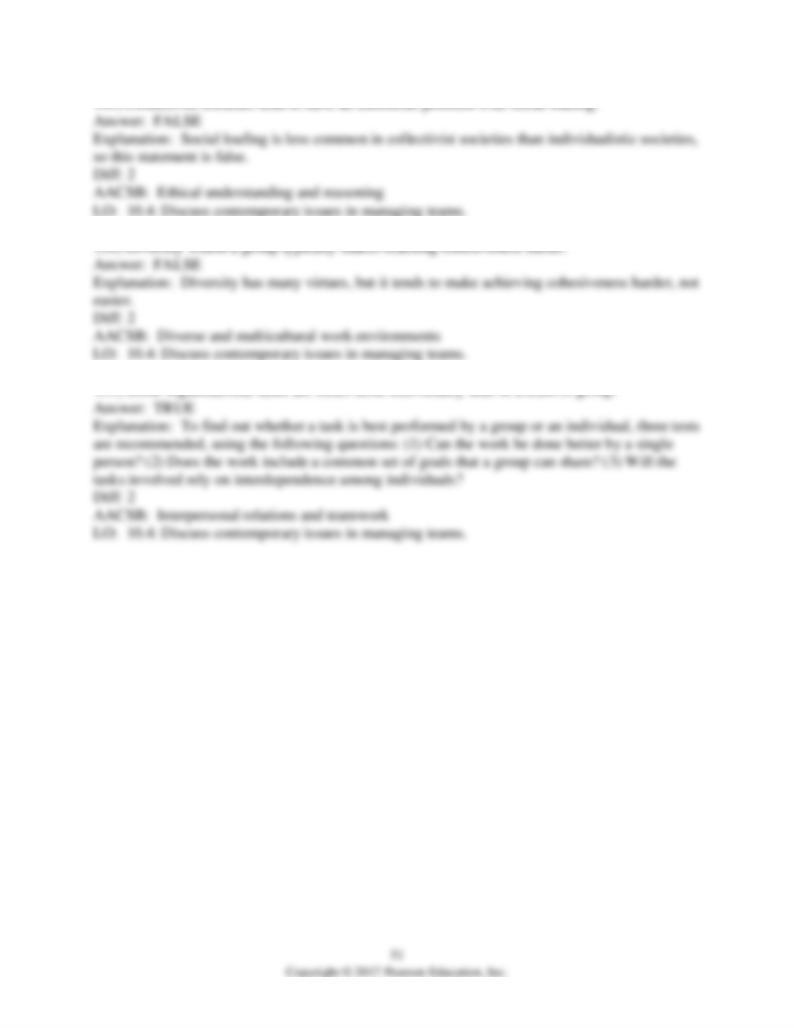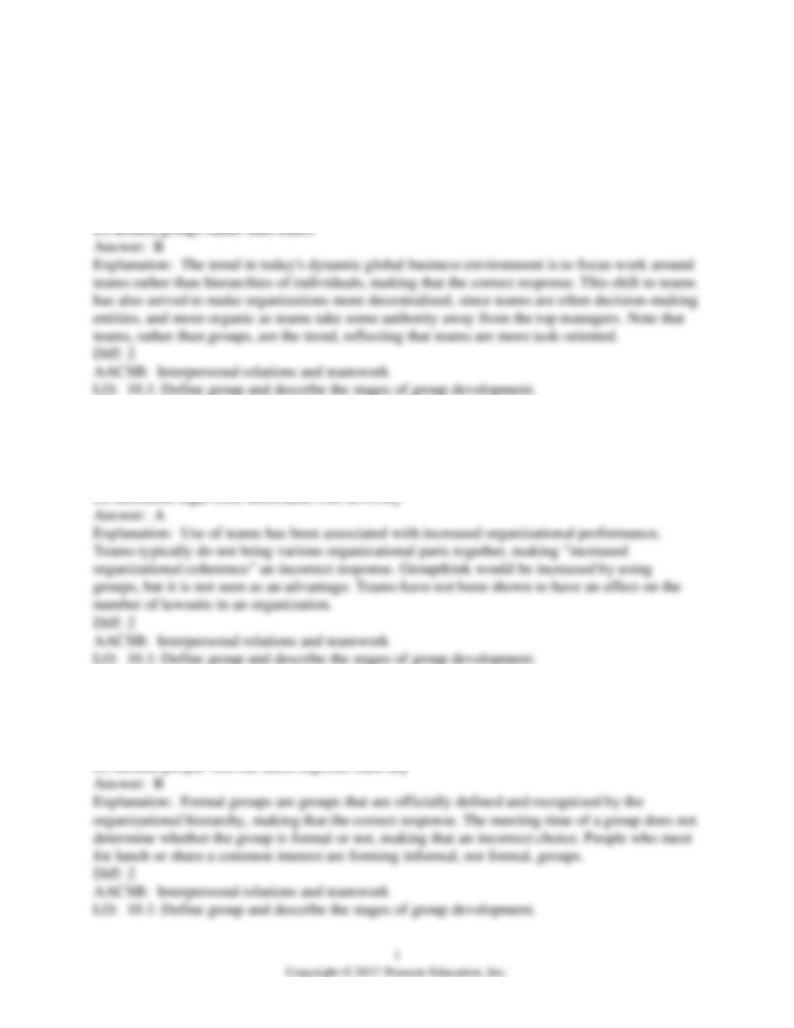
Fundamentals of Management, 10e (Robbins)
Chapter 10 Understanding Groups and Managing Work Teams
1) Many managers in today's business world have restructured work ________.
A) around individuals rather than teams
B) around teams rather than individuals
C) around both individuals and teams
2) Of the following, which is the main advantage of teams within an organization?
A) increased organizational performance
B) increased organizational coherence
C) increased groupthink
3) Formal groups ________.
A) meet at a regular time and place
B) are defined by an organization's structure
C) include people who share a common interest
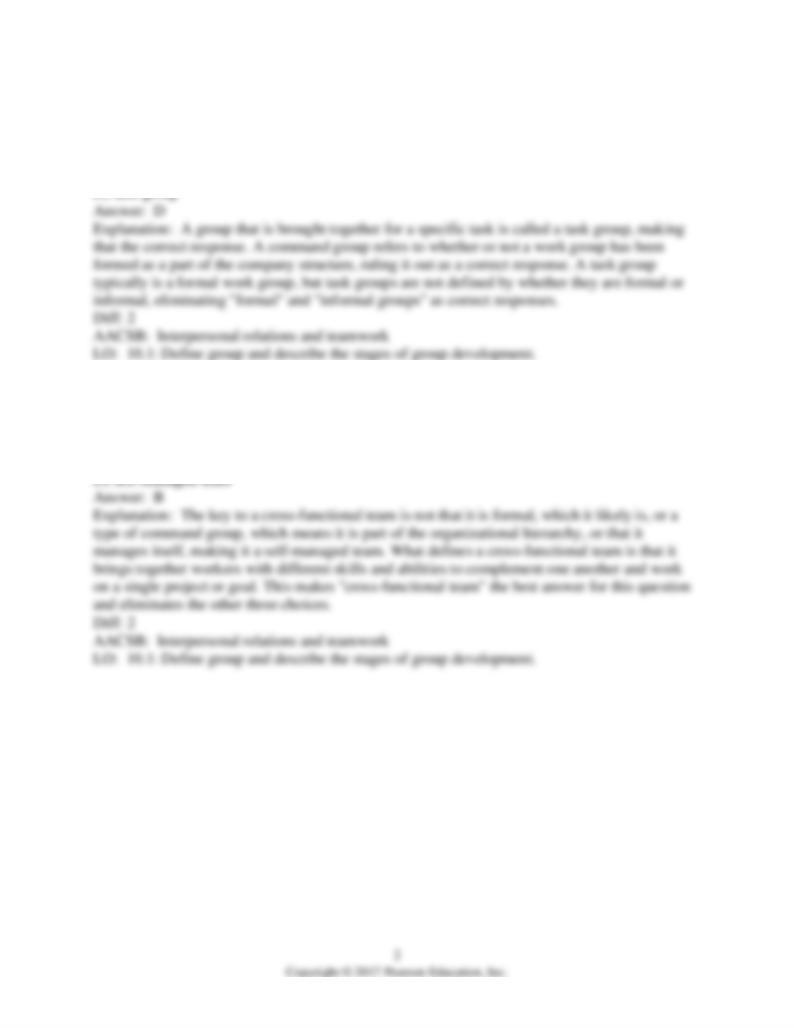
4) This kind of work group is brought together to accomplish a specific job or single activity,
such as the development of a new product.
A) command group
B) formal group
C) informal group
5) This kind of work group brings individuals together from different work disciplines with
different knowledge and skills.
A) formal group
B) cross-functional team
C) command group

6) The ________ stage of the group development process is complete when members begin to
think of themselves as part of a group.
A) forming
B) storming
C) norming
7) This stage involves the most conflict during the entire group development process.
A) forming
B) storming
C) norming
8) Norming is a stage of group development that occurs when ________.
A) the group struggles for leadership
B) the group defines its purpose
C) the group develops cohesiveness
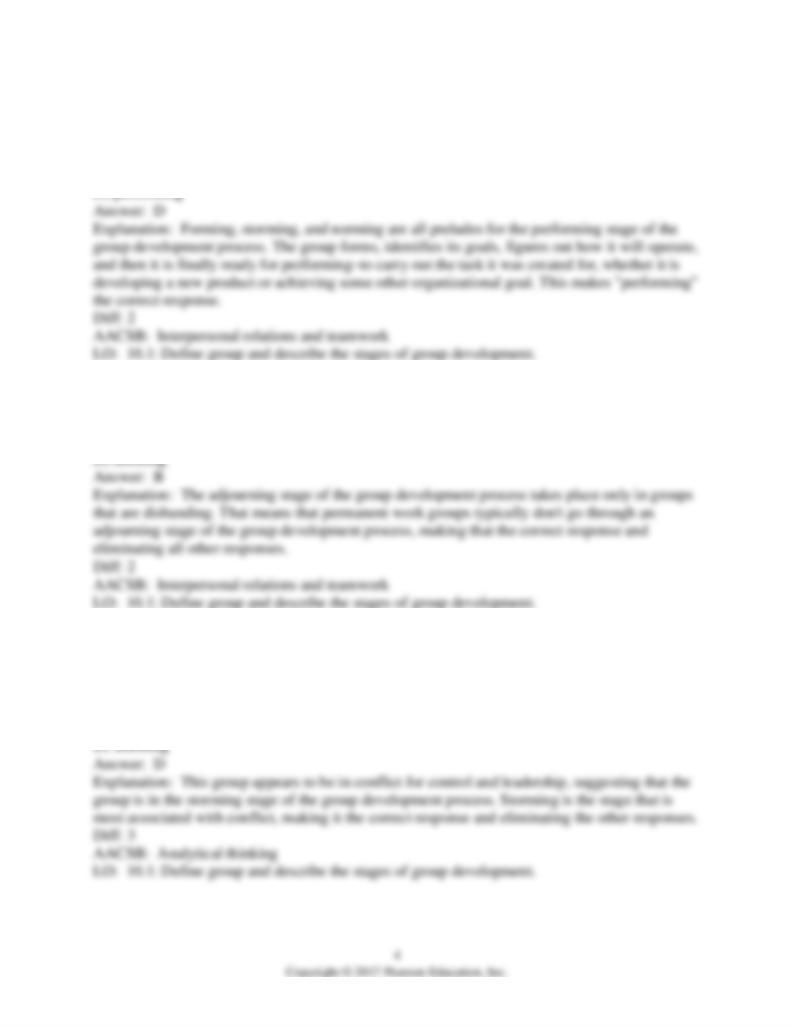
9) In which group development process is the group's energy directed to working on the group's
task?
A) storming
B) forming
C) norming
10) Permanent work groups are not likely to go through this stage.
A) storming
B) adjourning
C) forming
11) During a recent meeting, a shouting match arose between a design manager and a marketing
representative about a marketing plan for a new product. This team seems to be at the ________
stage of group development.
A) conflict
B) forming
C) norming

12) During the storming stage of group development, high levels of conflict ________.
A) are necessary for group cohesiveness
B) increase group cohesiveness
C) can contribute to group effectiveness
13) A group that has gone through the norming stage of the group development process
________.
A) never returns to the storming stage
B) always returns to the storming stage
C) never returns to the forming stage
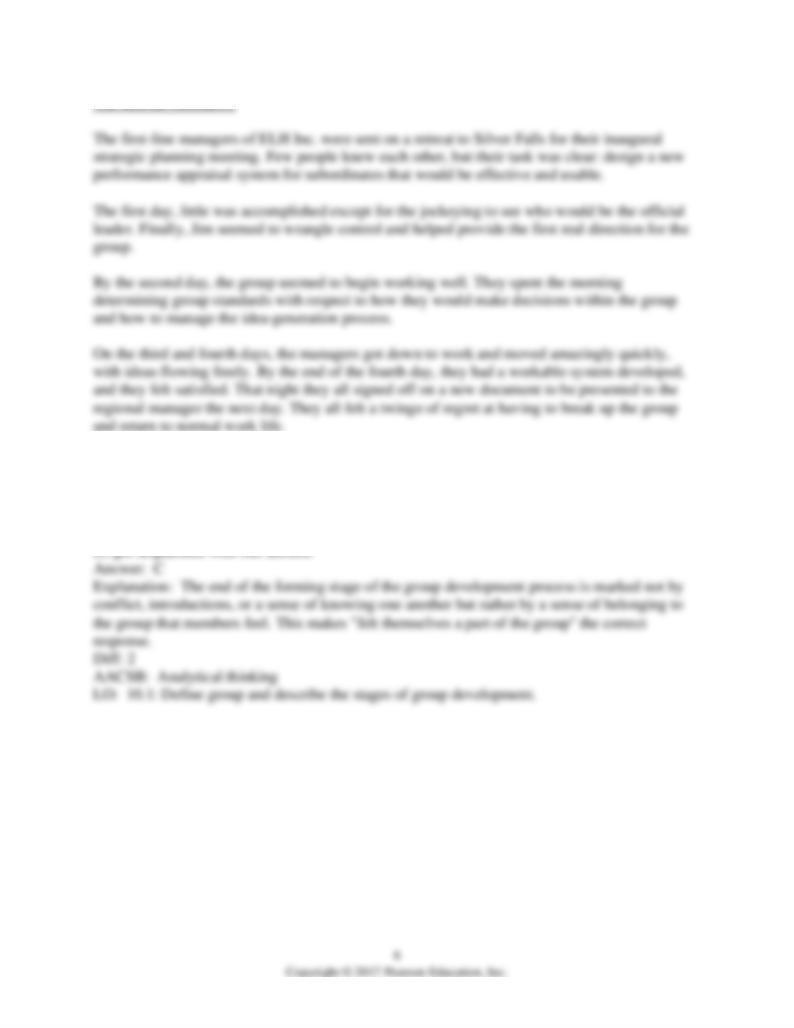
The Retreat (Scenario)
14) The official forming stage of the group development process wasn't complete until group
members ________.
A) experienced conflict
B) introduced one another
C) felt themselves a part of the group
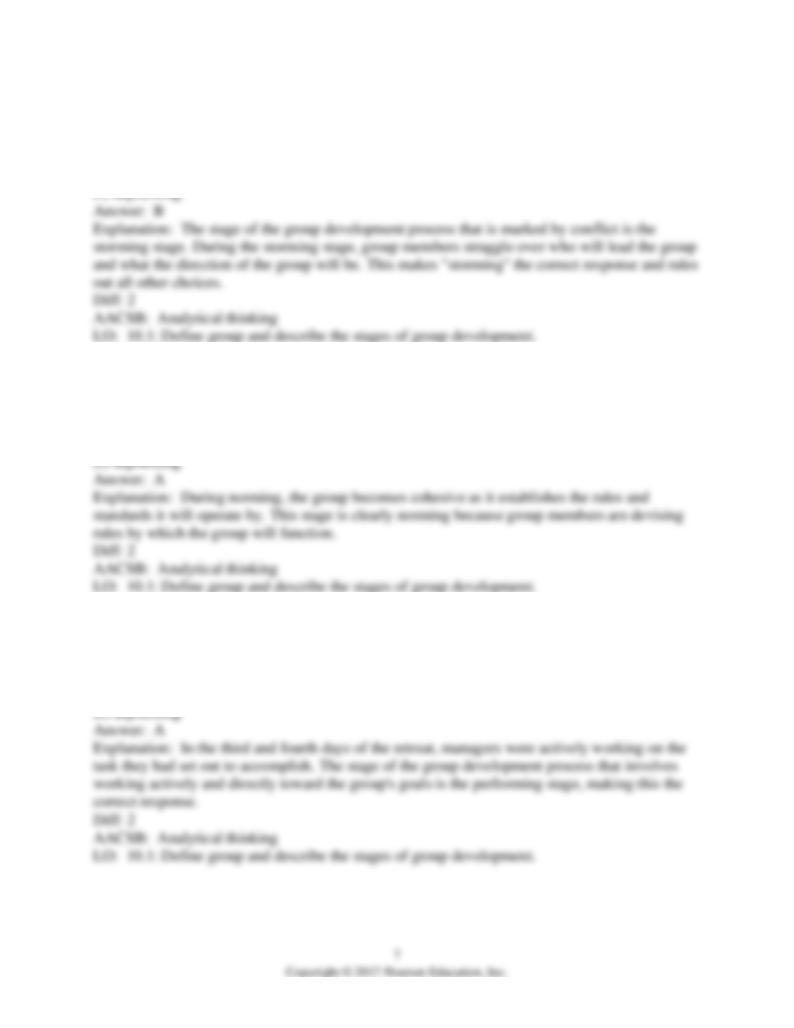
15) The group was in the ________ stage when it was competing to see who would lead the
group.
A) performing
B) storming
C) forming
16) When the management group was determining standards and establishing how it would make
decisions, it was in the ________ stage of group development.
A) norming
B) storming
C) forming
17) In the third and fourth days of the retreat, the managers were in the ________ stage of group
development.
A) performing
B) storming
C) forming
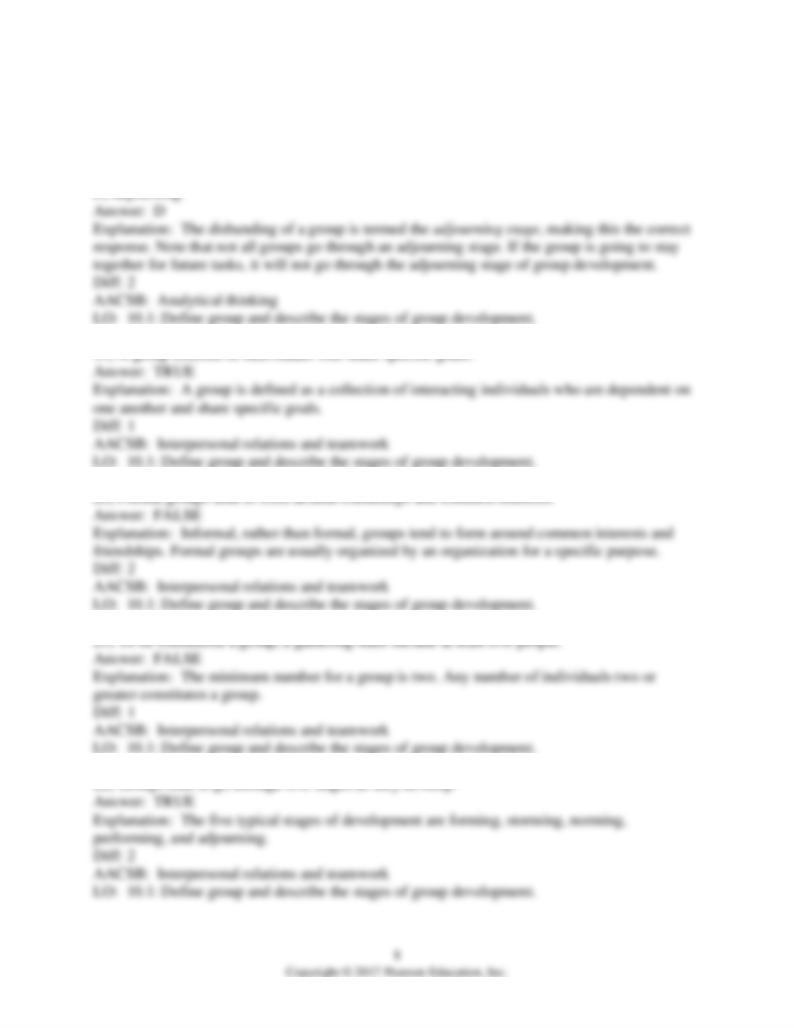
18) When the management team left Silver Falls to return to their own teams and departments,
they had just completed the ________ stage of group development.
A) performing
B) storming
C) forming
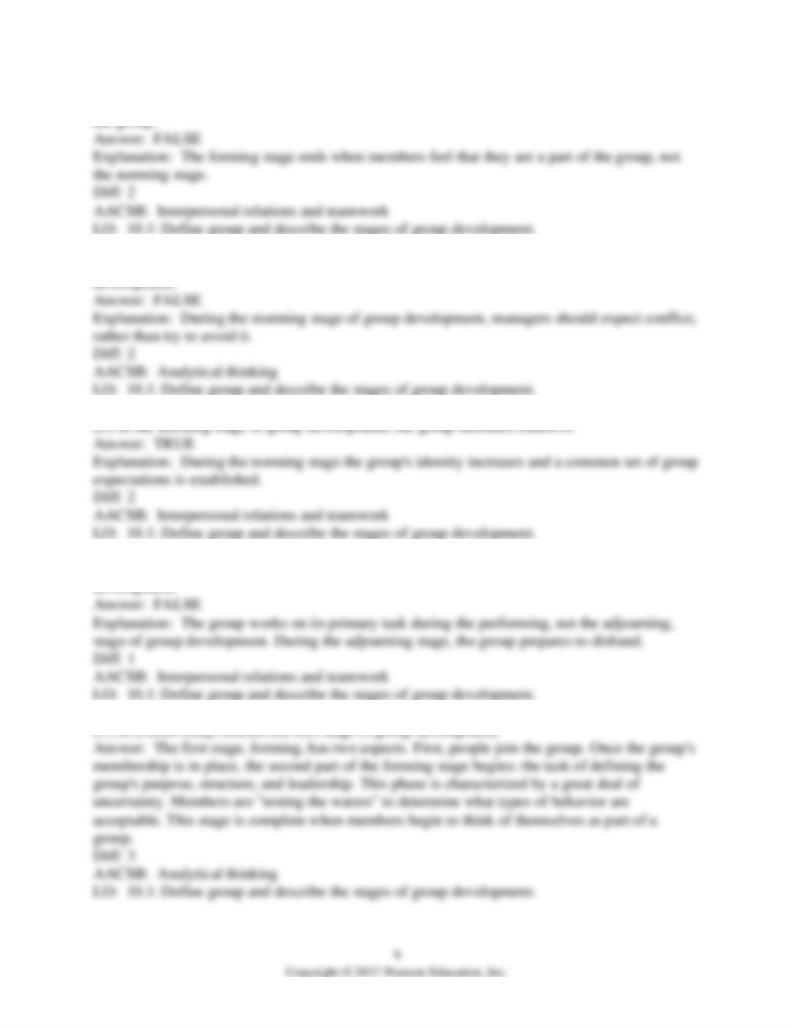
23) The norming stage of group development ends when members consider themselves a part of
24) Managers should especially try to avoid conflict during the storming stage of group
26) The group is likely to work on its primary task during the adjourning stage of group
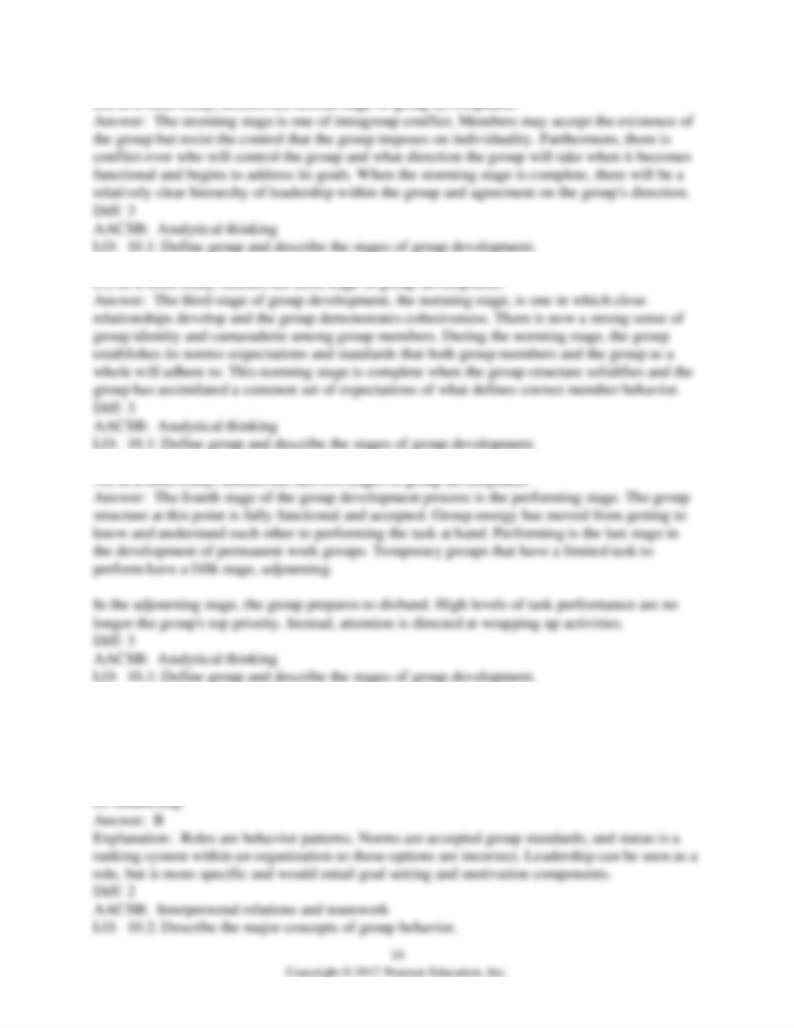
31) What term describes the behavior patterns of someone who occupies a given position in a
group?
A) Status
B) A role
C) A norm
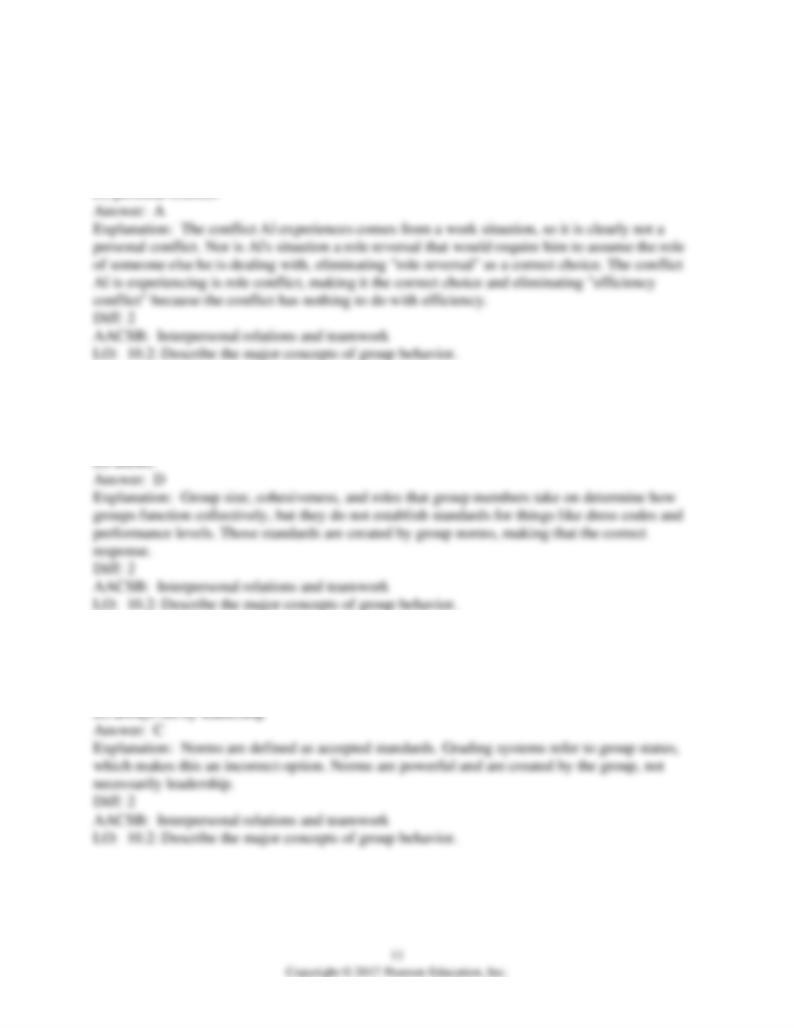
32) Al is given two different "top priorities" from two different managers. Al is experiencing
________.
A) role conflict
B) role reversal
C) efficiency conflict
33) Most workers learn what is expected as far as performance on the job from group ________.
A) roles
B) size
C) cohesiveness
34) Group norms typically are ________.
A) grading systems
B) not very powerful
C) accepted standards
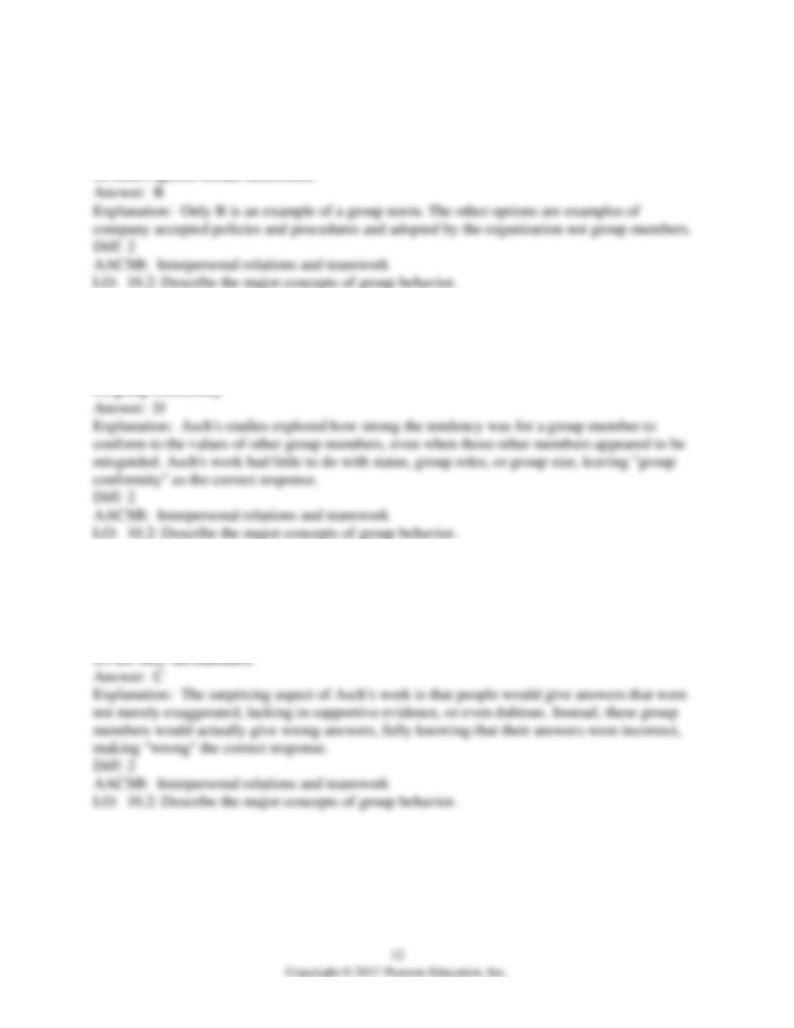
35) Which of the following would be an example of a group norm?
A) Company policies on absenteeism
B) Acceptable ways of dressing
C) Hiring policies prohibiting discrimination
36) Solomon Asch carried out pioneering studies in understanding ________.
A) group status
B) group roles
C) group size
37) Asch was surprised most by finding that in some conditions, group members would provide
information that they knew to be ________.
A) slightly exaggerated
B) vague
C) wrong
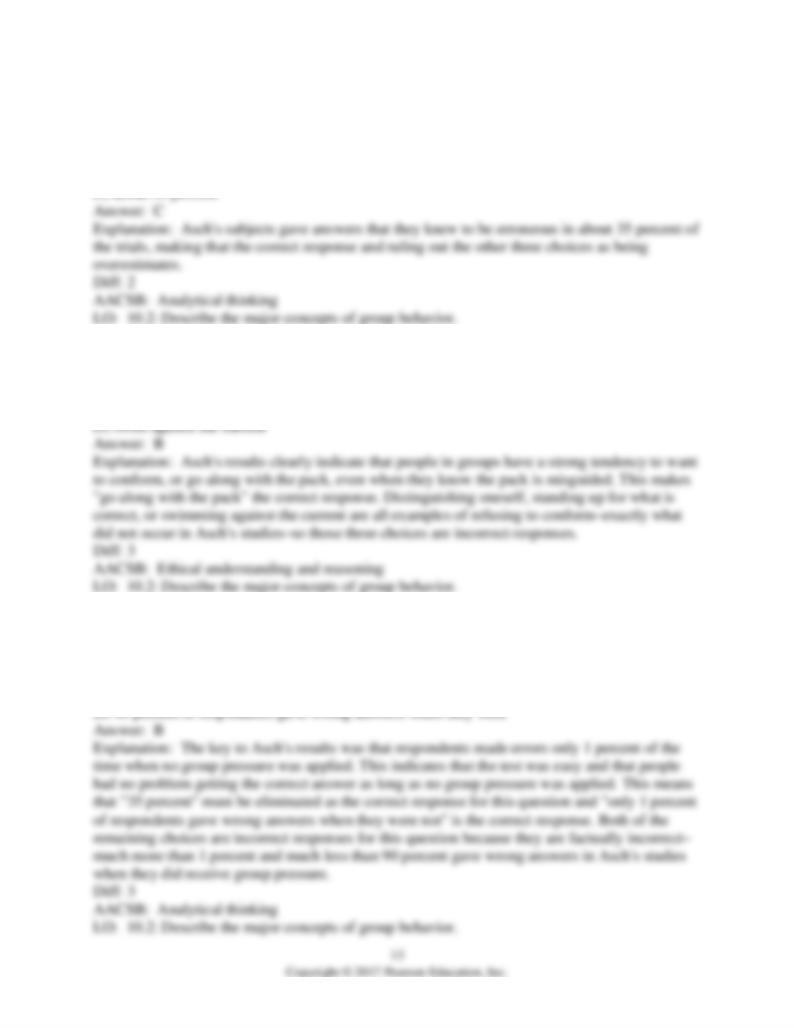
38) Asch's subjects were seen to give incorrect answers that they knew were incorrect in
________ of his studies.
A) about half
B) more than half
C) about 35 percent
39) Asch's results are attributed to the tendency of people in groups to ________.
A) try to distinguish themselves
B) go along with the pack
C) stand up for what they know is right
40) Asch could feel fairly confident that his results were legitimate because ________ pressured
by the group.
A) 35 percent of respondents gave wrong answers when they were not
B) only 1 percent of respondents gave wrong answers when they were not
C) only 1 percent of respondents gave wrong answers when they were
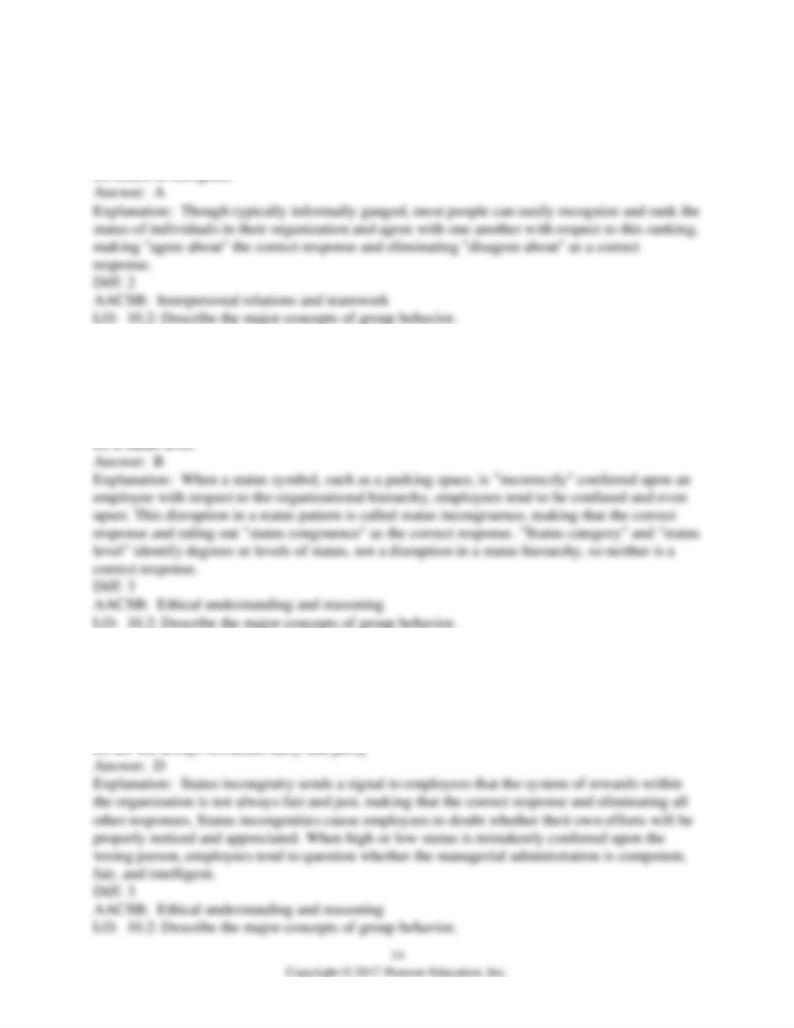
41) Members of an organization typically ________ the status of other organizational members.
A) agree about
B) disagree about
C) cannot recognize
42) A low-ranking employee having the best parking space in the company parking lot is an
example of ________.
A) status congruence
B) status incongruence
C) a status category
43) Status incongruence can be upsetting to employees because it sends a signal that
organizational accomplishments ________.
A) are rewarded fairly and justly
B) are always rewarded
C) are never rewarded
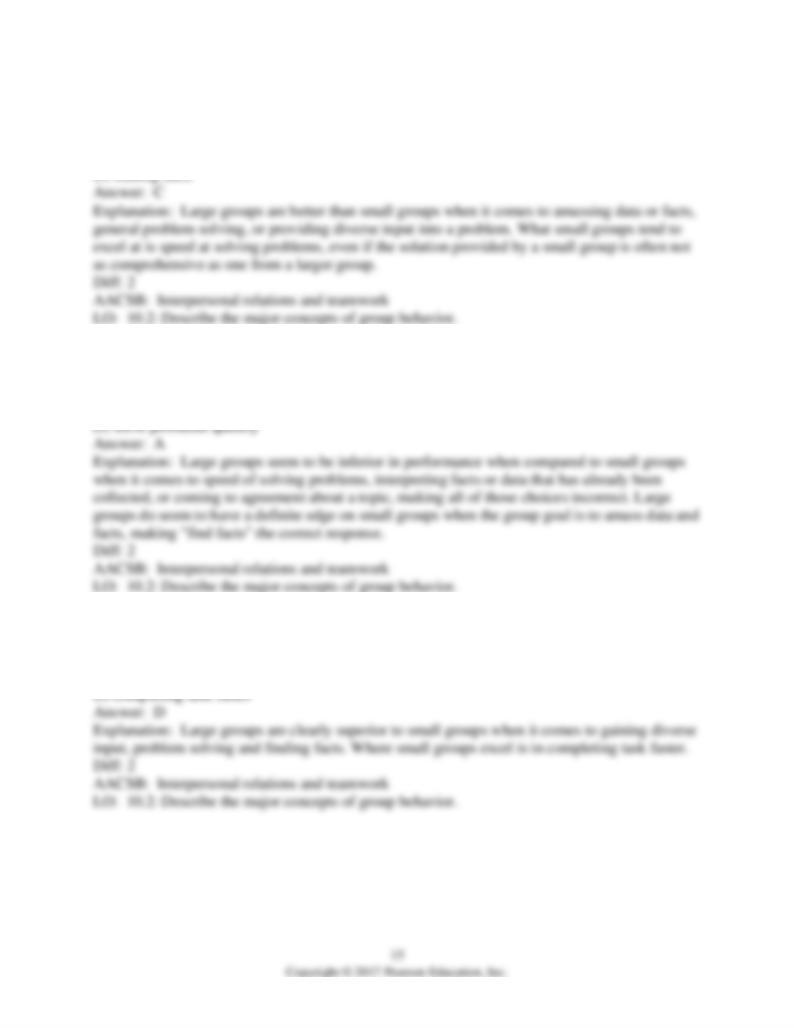
44) Small groups appear to perform better when it comes to ________.
A) problem solving
B) getting diverse input into a problem
C) speed of performing tasks
45) Large groups appear to perform better when the goal of the group is to ________.
A) find facts
B) create consensus on a new product
C) interpret facts
46) Small groups appear to perform better when it comes to ________.
A) gaining diverse input
B) finding facts
C) problem solving
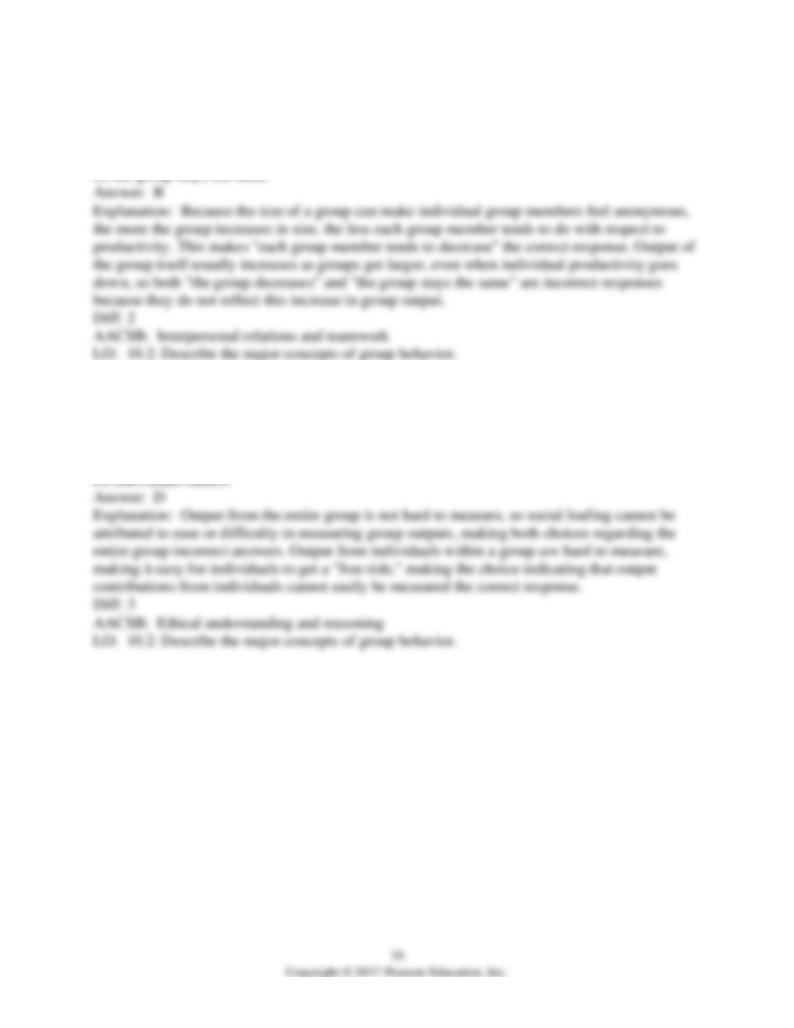
47) As the size of a group increases, the output of ________.
A) each group member tends to increase
B) each group member tends to decrease
C) the group decreases
48) The primary reason for why social loafing occurs is that output contributions from ________
easily be measured.
A) the entire group can
B) the entire group cannot
C) individuals can
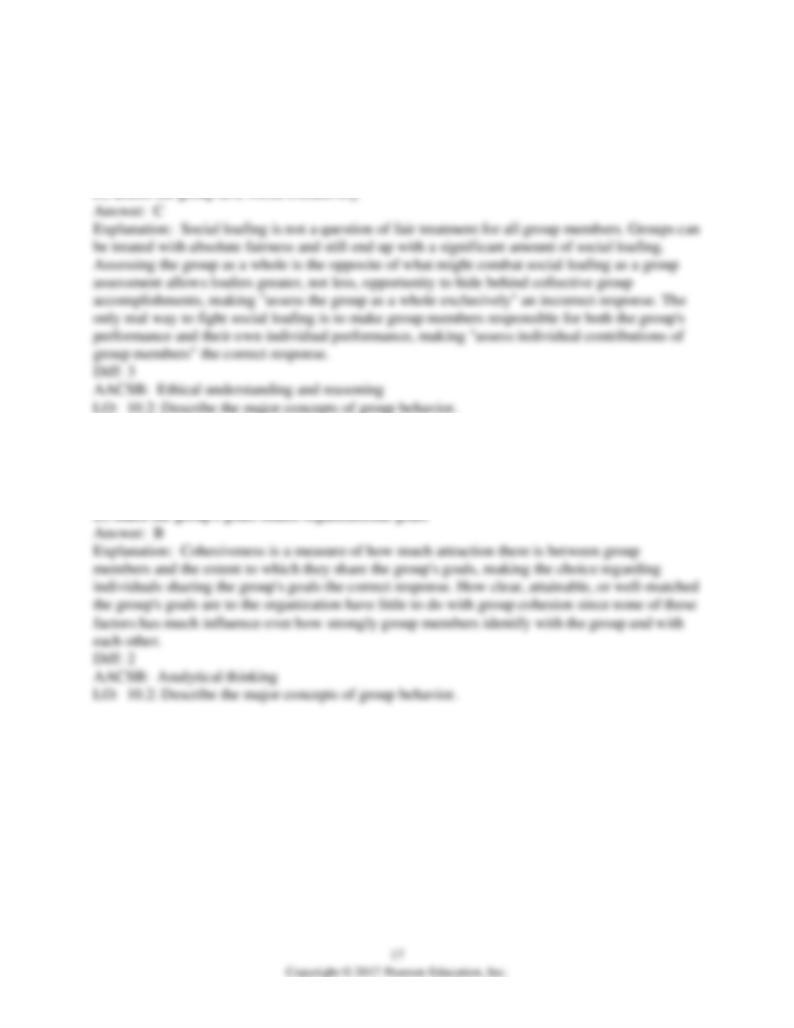
49) The only effective way to guard against social loafing is for managers to make special efforts
to do this.
A) be fair to all group members
B) treat all group members equally
C) assess individual contributions of group members
50) Group cohesiveness is largely a measure of how ________.
A) clear the group's goals are
B) much individuals share the group's goals
C) attainable the group's goals are
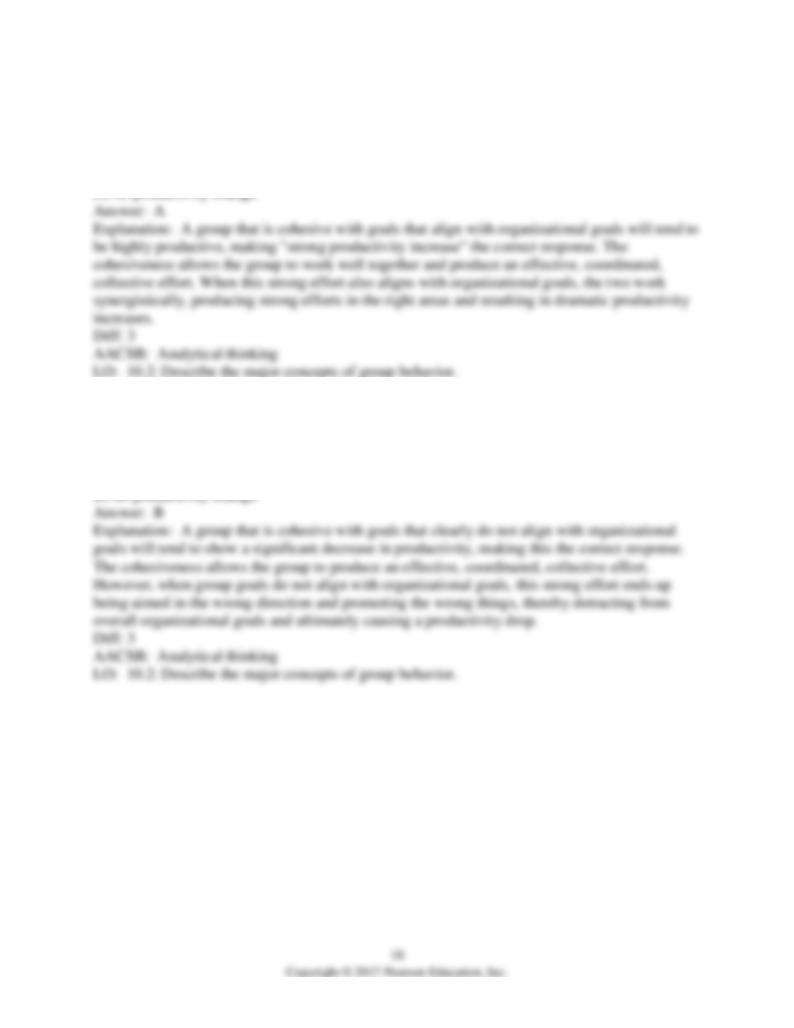
51) High cohesiveness combined with a strong alignment between group goals and
organizational goals typically results in this.
A) strong productivity increase
B) strong productivity decrease
C) small productivity decrease
52) High cohesiveness combined with a very weak alignment between group goals and
organizational goals typically results in this.
A) a small productivity increase
B) a productivity decrease
C) a large productivity increase
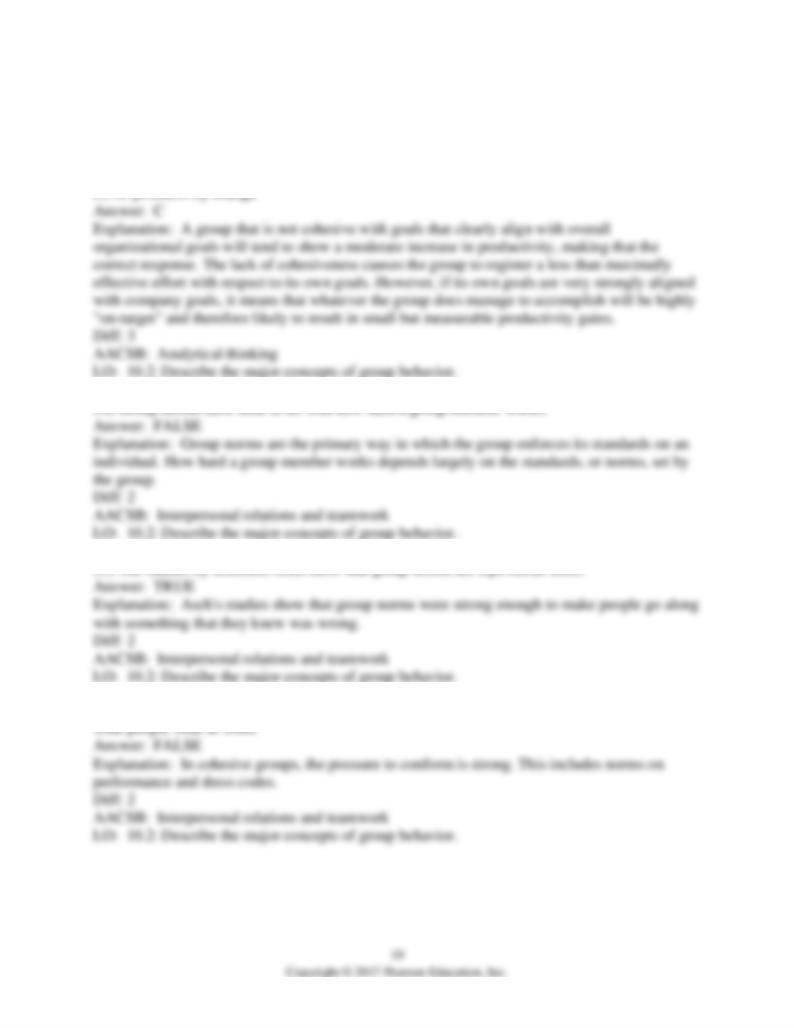
53) Low cohesiveness combined with a strong alignment between group goals and organizational
goals typically results in this.
A) a small productivity increase
B) a productivity decrease
C) a moderate productivity increase
56) Group norms affect dynamics such as effort and performance, but not superficial things like
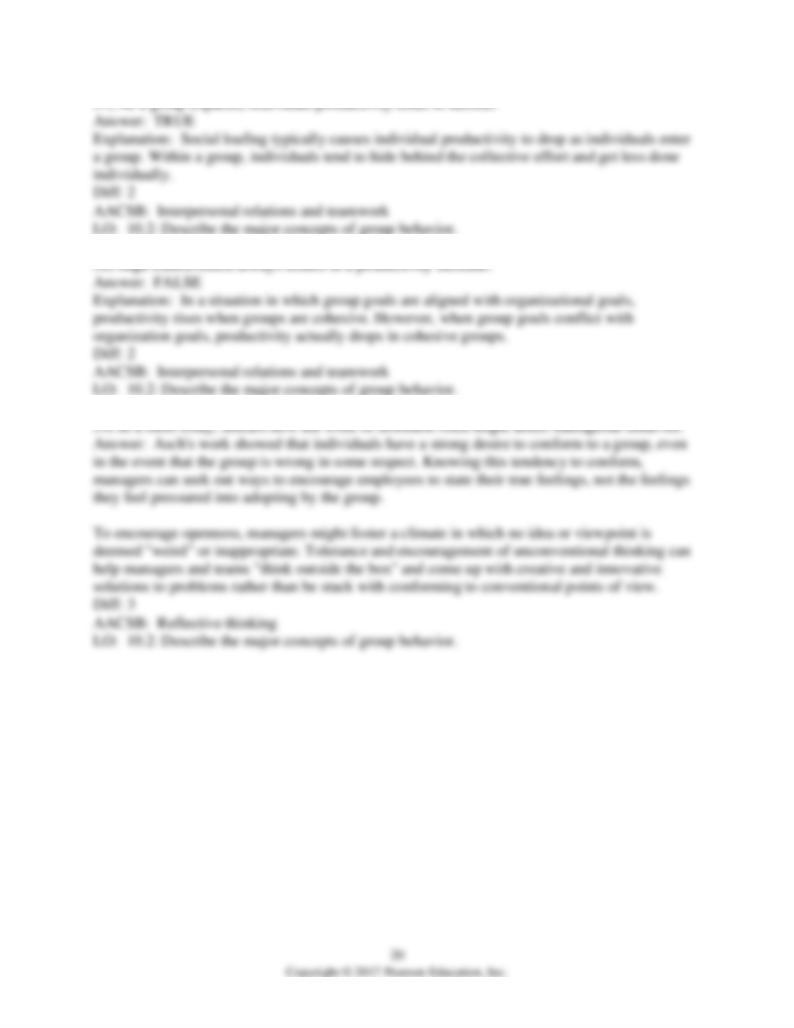
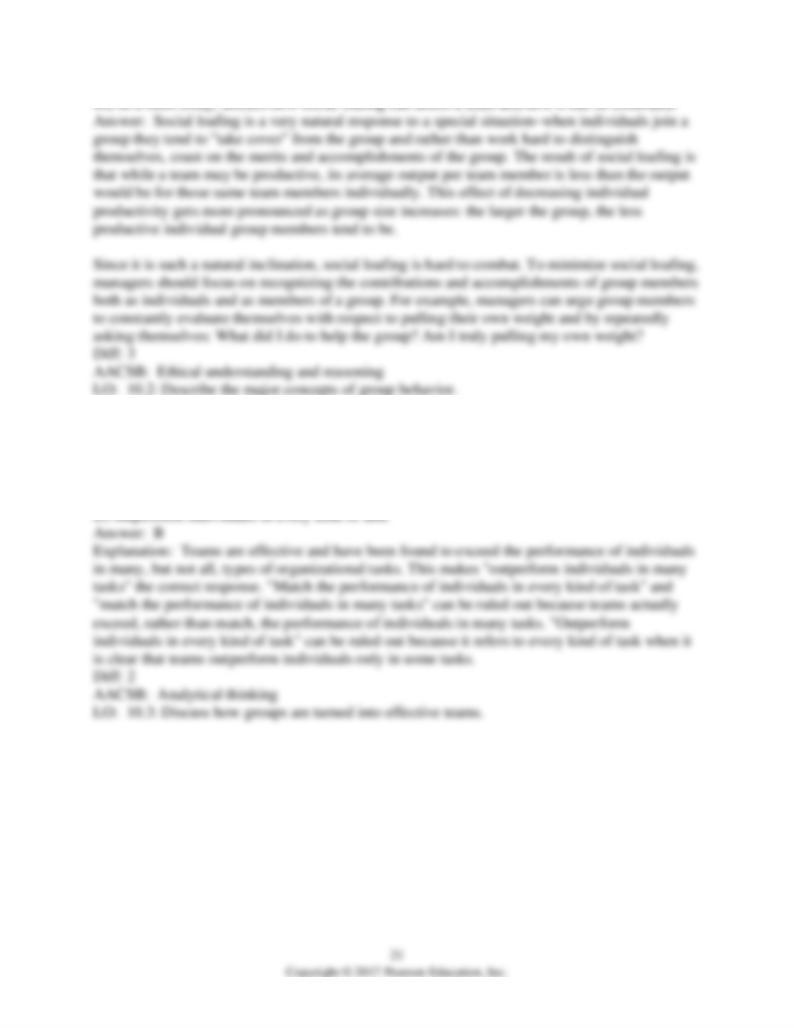
61) Teams are increasingly popular among successful organizations because they have been
found to ________.
A) match the performance of individuals in every kind of task
B) outperform individuals in many tasks
C) match the performance of individuals in many tasks

62) Which statement is true of Fortune 500 companies?
A) Half have 100 percent of their employees on teams.
B) 100 percent have half of their employees on teams.
C) 80 percent have half of their employees on teams.
63) Which of the following is NOT generally thought to be an advantage of teams over
traditional work arrangements?
A) Teams are flexible and responsive.
B) Teams are easy to assemble.
C) Teams are easy to disband.
64) The main difference between work groups and work teams is that ________.
A) work teams have a common goal
B) work groups have a common goal
C) work teams share information
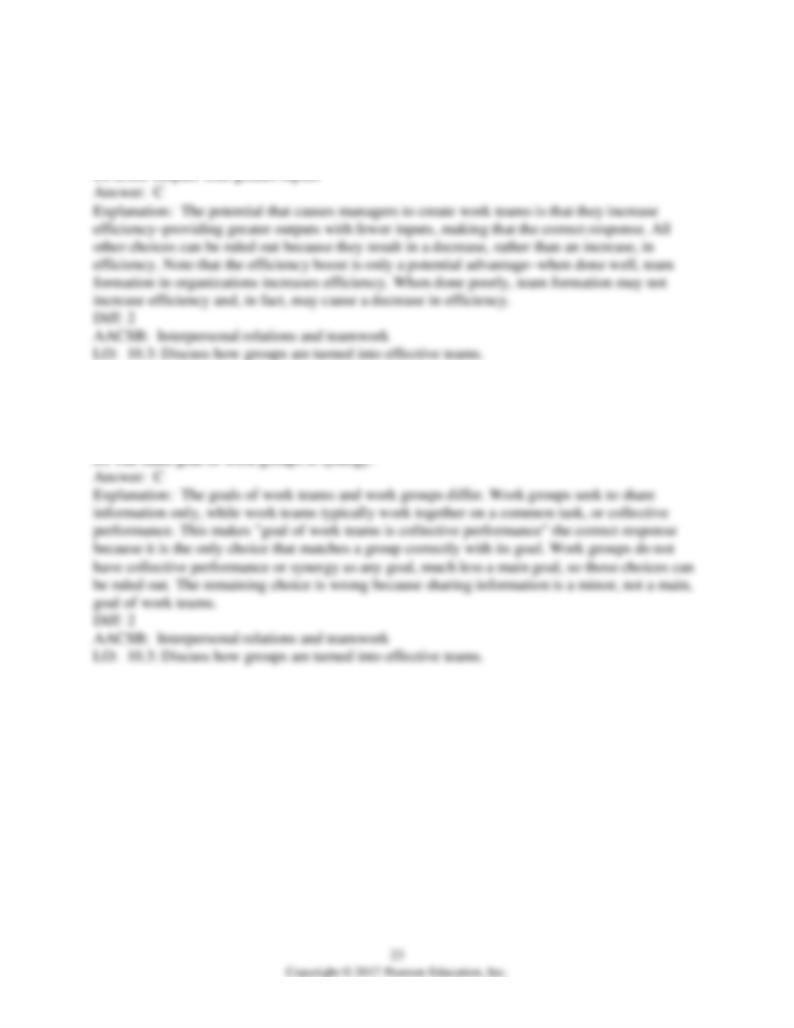
65) The use of work teams creates the potential for an organization to generate ________.
A) greater outputs with greater inputs
B) fewer outputs with fewer inputs
C) greater outputs with fewer inputs
66) Which statement is true?
A) The main goal of work teams is to share information.
B) The main goal of work groups is collective performance.
C) The main goal of work teams is collective performance.
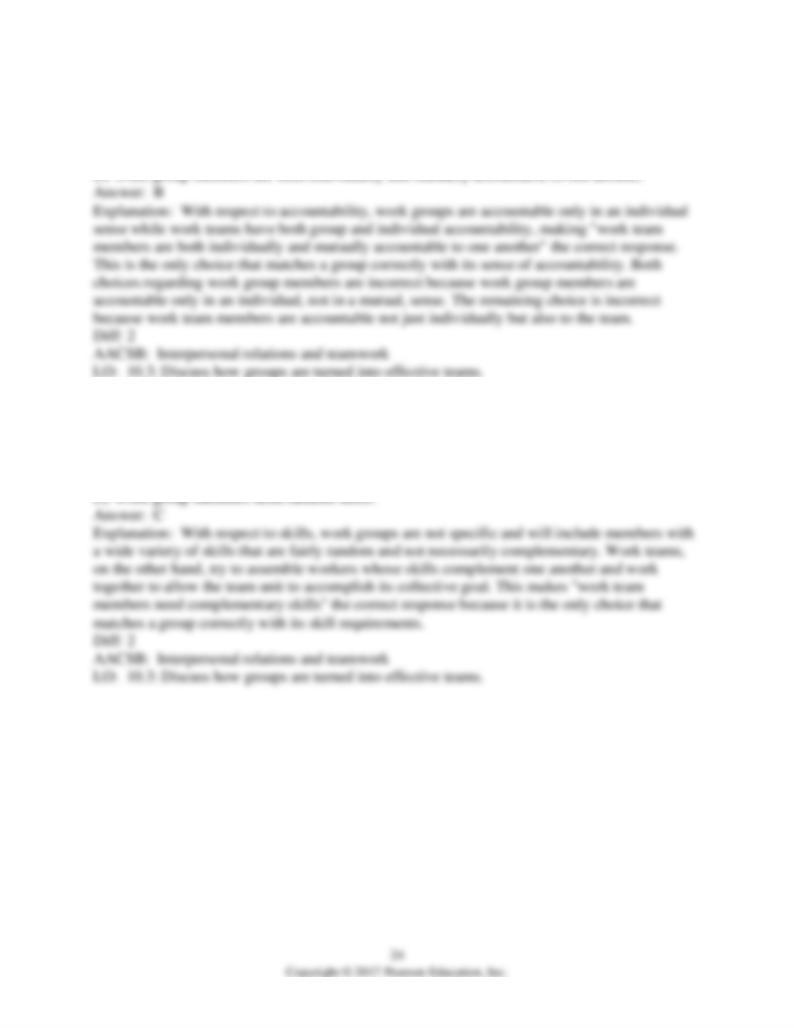
67) Which statement is true of accountability?
A) Work team members are individually accountable only.
B) Work team members are both individually and mutually accountable to one another.
C) Work group members are mutually accountable to one another.
68) Which statement is true of the skills that members of work groups and work teams must
have?
A) Work group members need complementary skills.
B) Work team members need random skills.
C) Work team members need complementary skills.
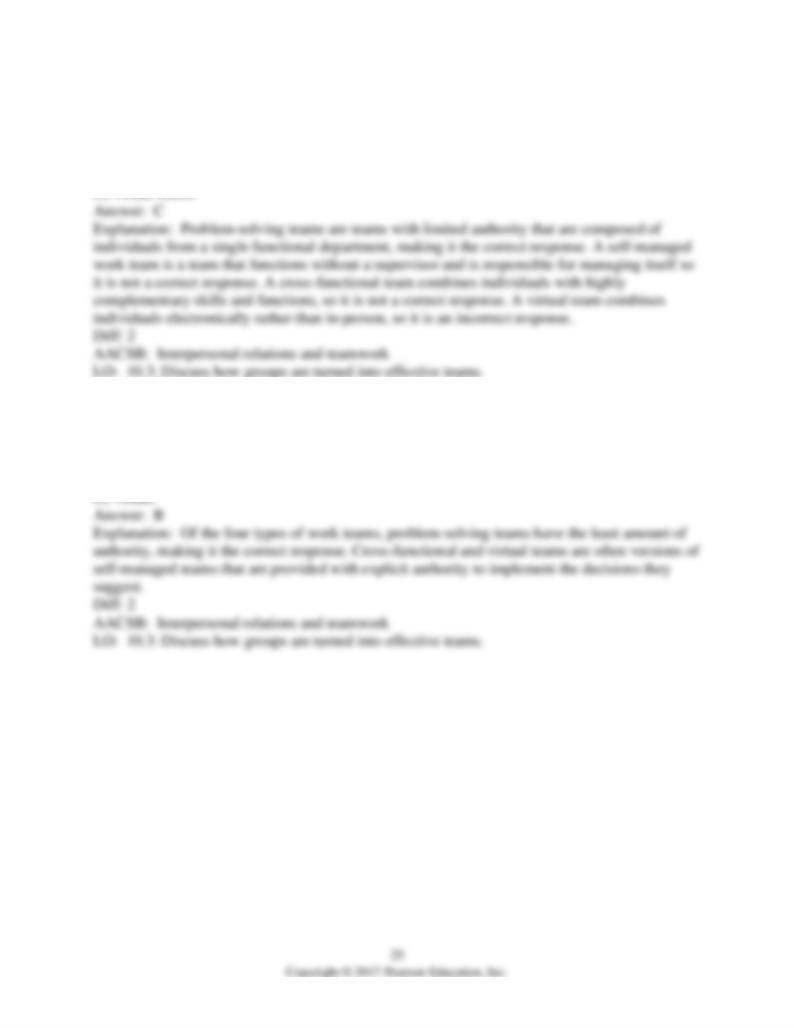
69) Teams composed of individuals from the same department or functional area and are
involved in efforts to improve work activities are called ________.
A) cross-functional teams
B) self-managed work teams
C) problem-solving teams
70) Which type of team is rarely given the authority to unilaterally implement any of its
suggested actions?
A) cross-functional
B) problem-solving
C) self-managed
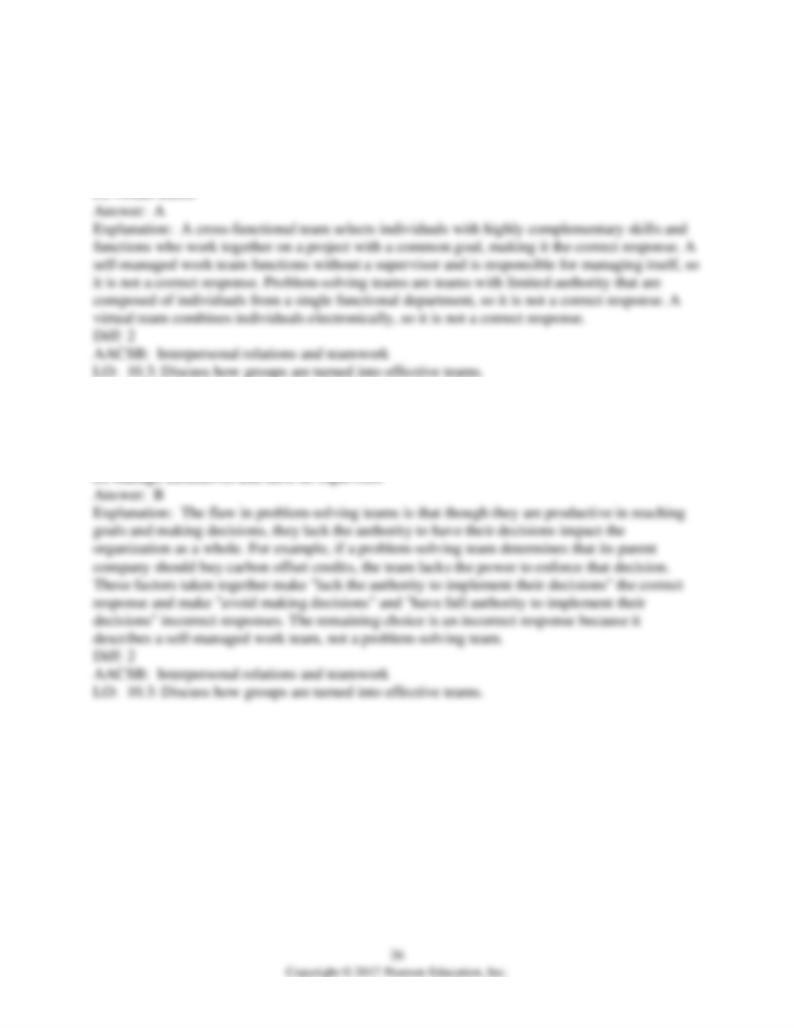
71) Teams composed of individuals with skills that are highly complementary to one another are
called ________.
A) cross-functional teams
B) self-managed work teams
C) problem-solving teams
72) Problem-solving teams usually ________.
A) have full authority to implement their decisions
B) lack the authority to implement their decisions
C) avoid making decisions
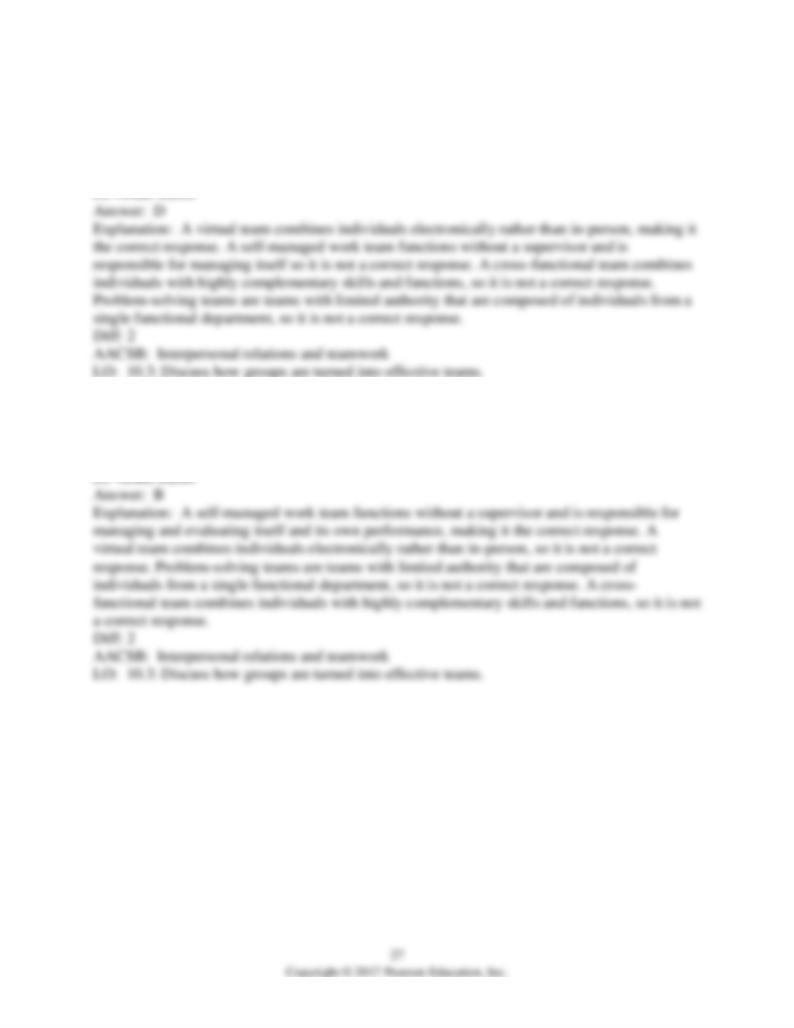
73) Teams composed of individuals who have rarely actually met one another in person are
called ________.
A) cross-functional teams
B) self-managed work teams
C) problem-solving teams
74) Teams composed of individuals who function without a supervisor are called ________.
A) cross-functional teams
B) self-managed work teams
C) problem-solving teams
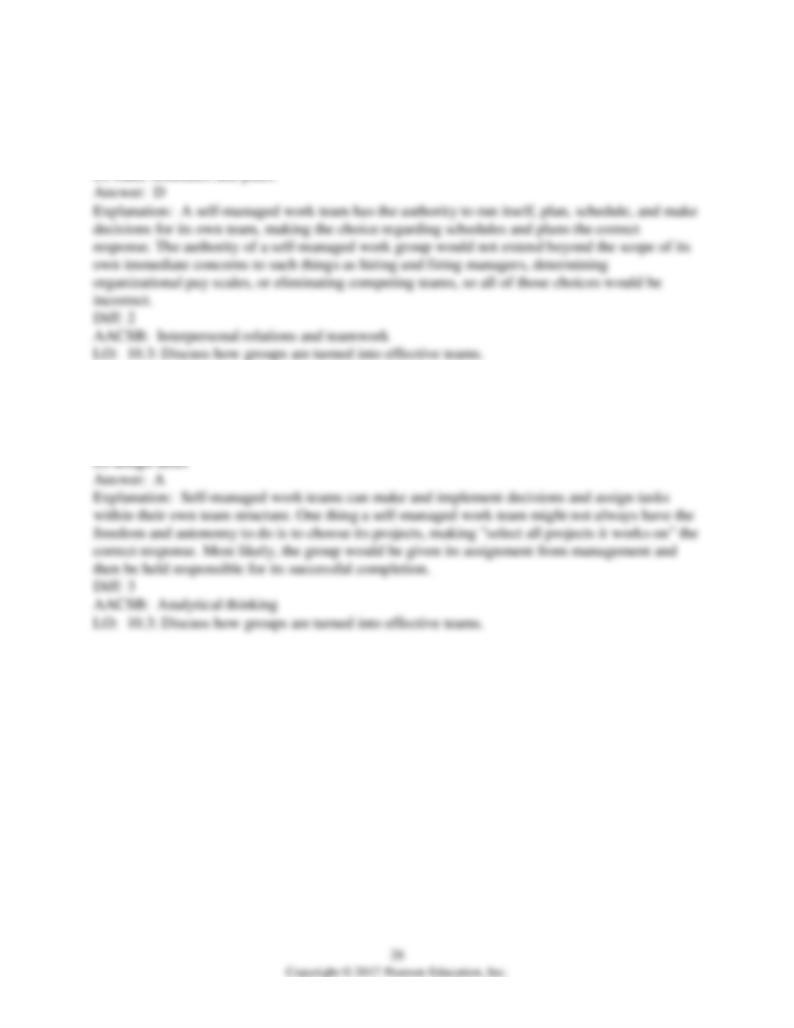
75) A self-managed work team would be likely to have the authority to ________.
A) hire and fire top organizational managers
B) determine organization-wide pay scales for team employees
C) disband a competing work team
76) Which of the following would a self-managed work team be LEAST likely to do?
A) select all projects it works on
B) make decisions
C) implement decisions it makes
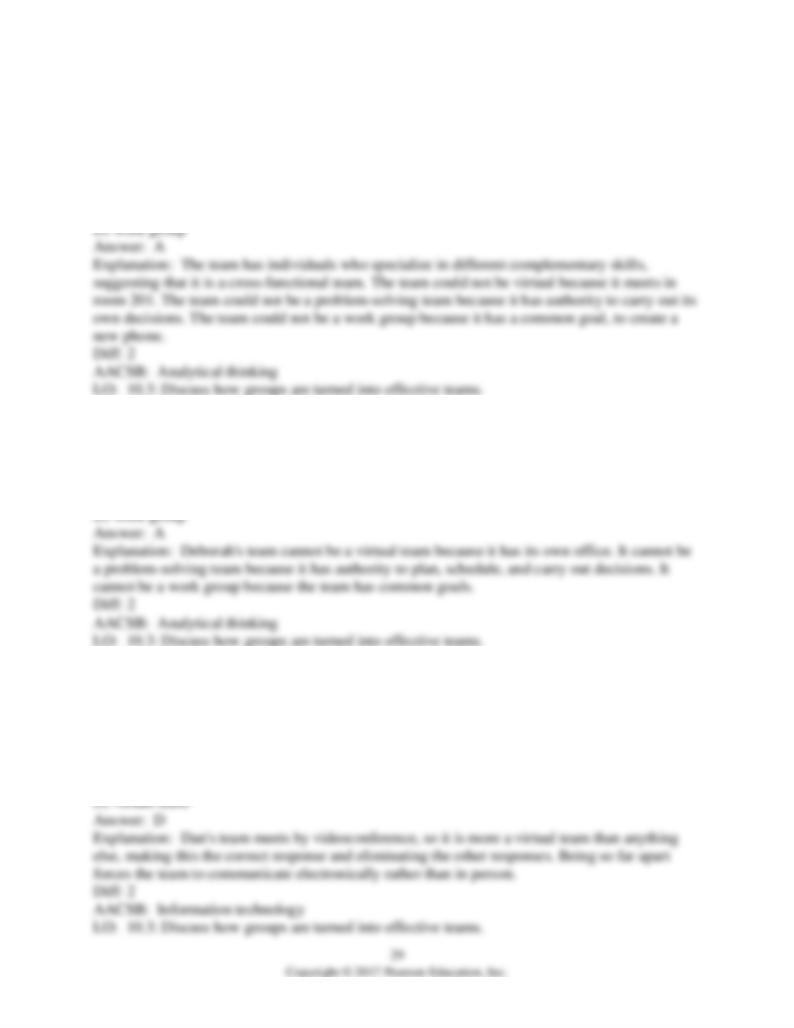
77) The team that meets each week in room 201 has a goal of creating a new cell phone model.
The team consists of an engineer, a designer, a computer software specialist, and a marketing
specialist. The team has full authority to make and implement its own decisions. This is likely to
be a ________.
A) cross-functional team
B) problem-solving team
C) virtual team
78) Deborah's work team has its own separate office, does its own planning and scheduling, and
is even responsible for evaluating each other's performance. Deborah is part of a ________ team.
A) self-managed
B) virtual
C) problem-solving
79) Dan in New York is part of a team that is creating new software for the One Laptop Per
Child program. The graphic designer for Dan's team is in Uruguay. The programmers for the
team are in different parts of California. The team meets by videoconference once a week. Dan's
team is likely to be a ________.
A) work group
B) functional team
C) cross-functional team
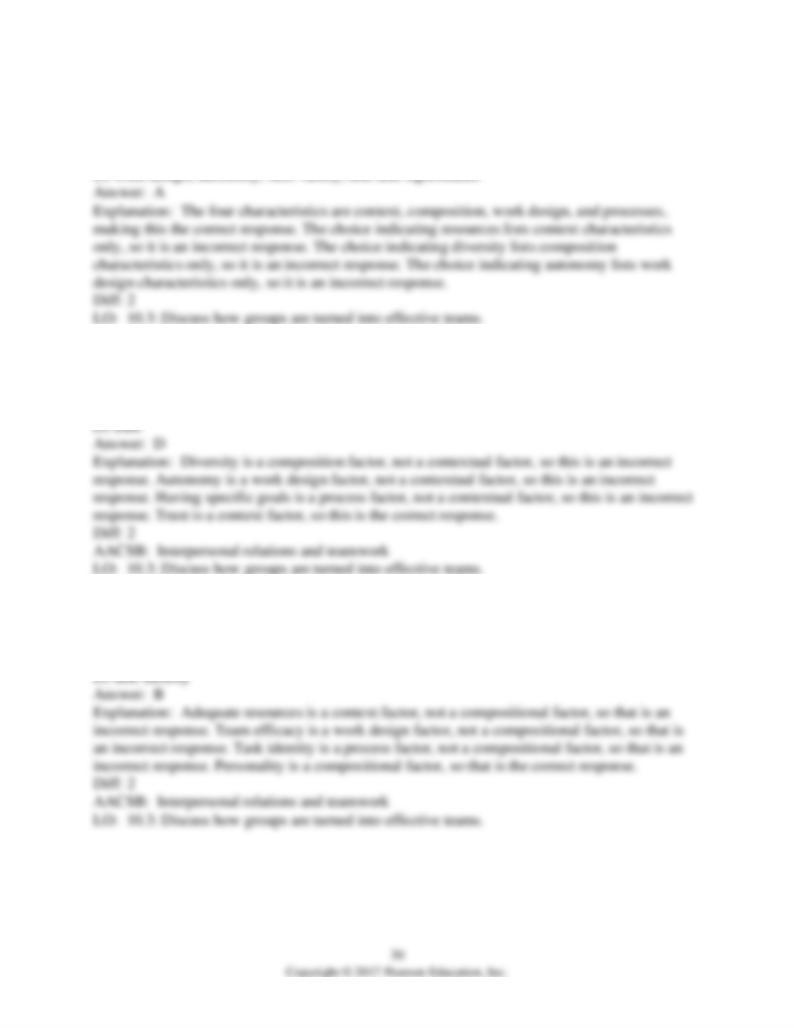
80) The characteristics that make a team effective include ________.
A) context, composition, work design, and processes
B) context, resources, leadership, and trust
C) composition, diversity, personality, and size
81) A major contextual factor that contributes to making a team effective is ________.
A) diversity
B) autonomy
C) having specific goals
82) A major compositional factor that contributes to making a team effective is ________.
A) adequate resources
B) personality
C) team efficacy
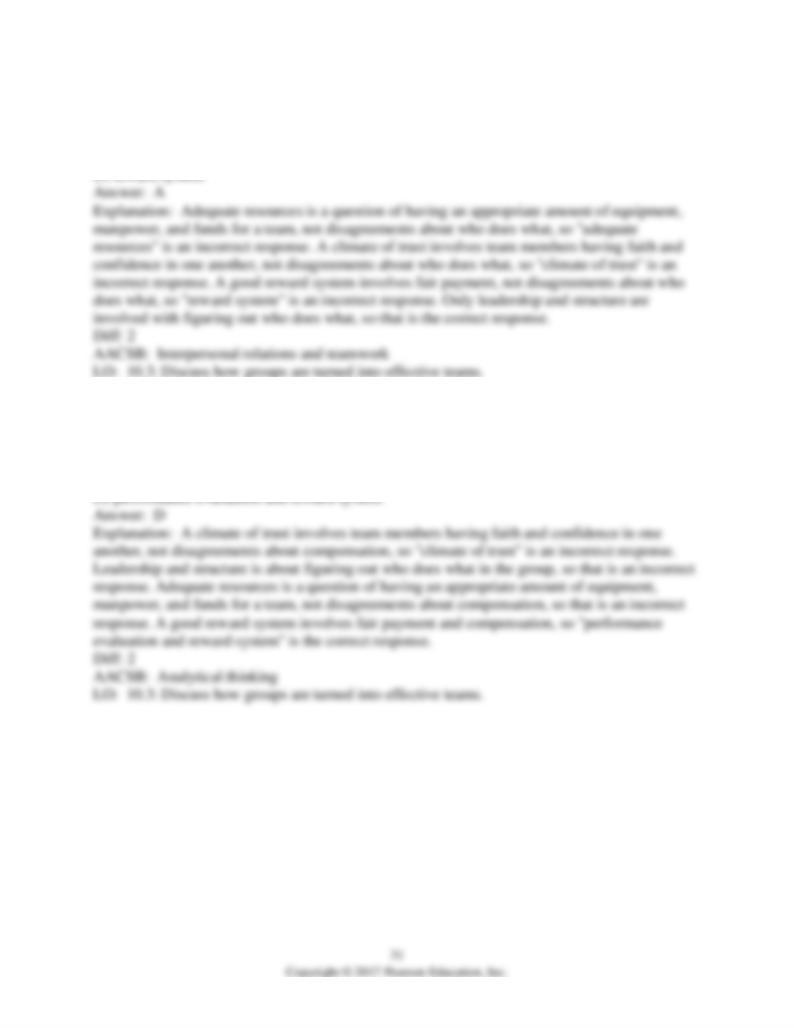
83) When a team can't agree on who does what, it is having this kind of contextual problem.
A) leadership and structure
B) adequate resources
C) climate of trust
84) When team members complain that they aren't being paid enough, the team has this kind of
contextual problem.
A) leadership and structure
B) adequate resources
C) climate of trust
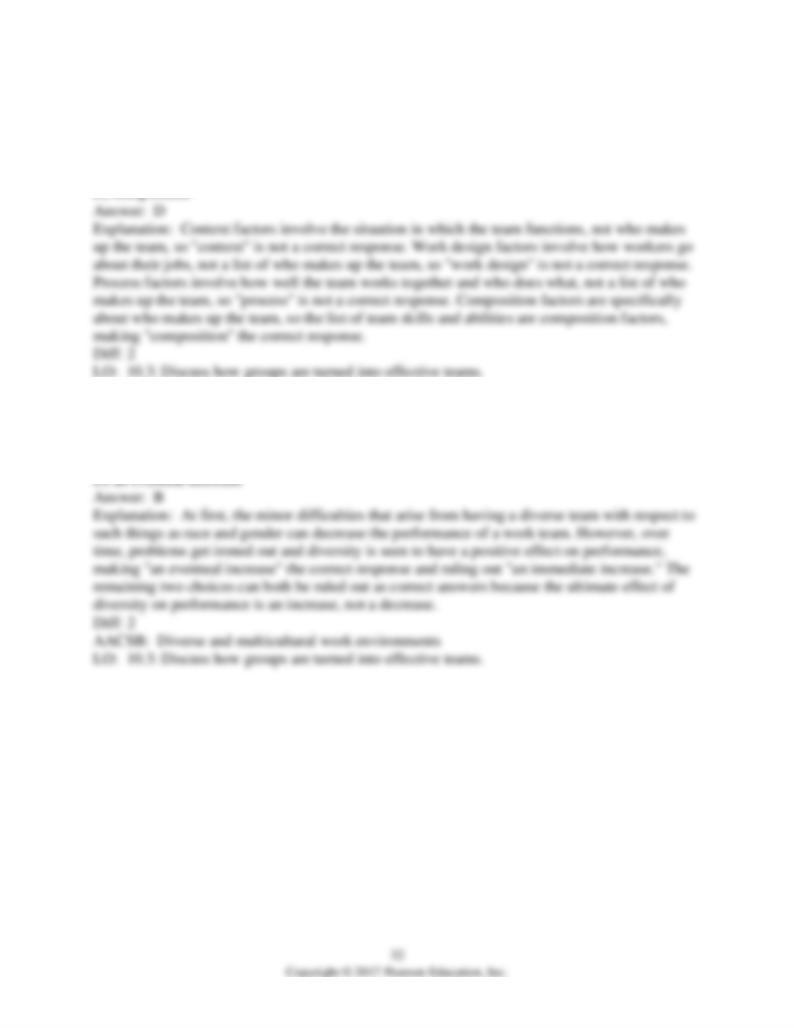
85) The knowledge, skills, and abilities of team members are ________ factors that contributes
to team effectiveness.
A) context
B) work design
C) process
86) Team diversity generally leads to ________ in overall team performance.
A) an immediate increase
B) an eventual increase
C) a dramatic decrease
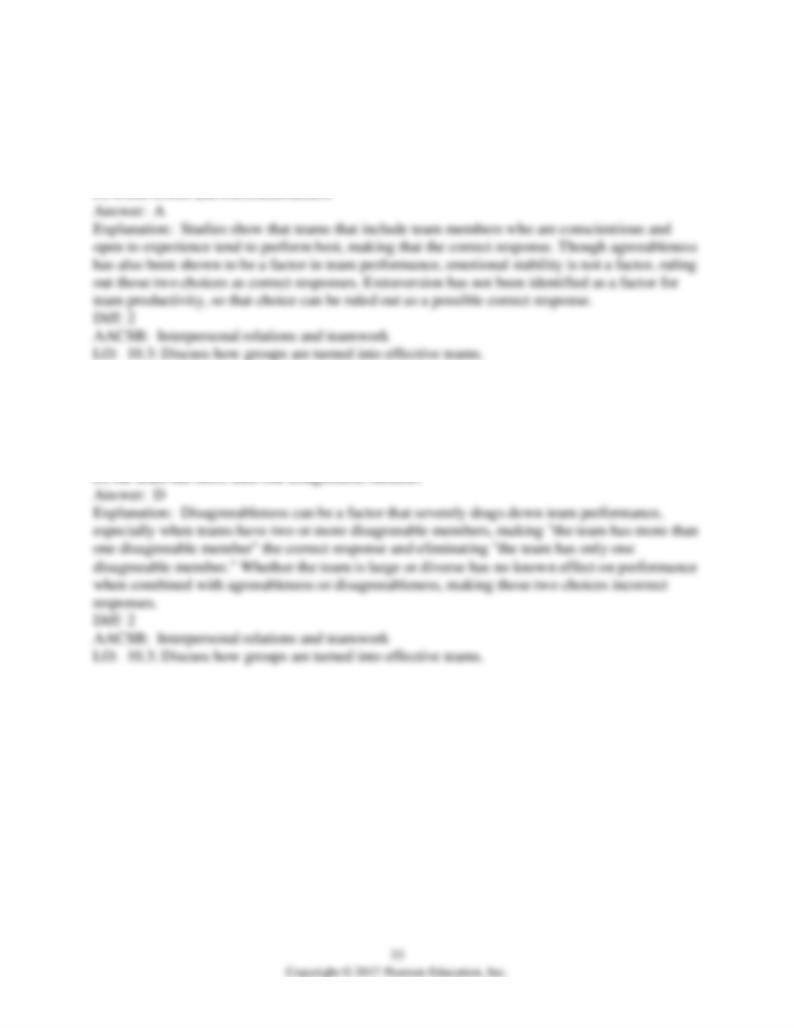
87) These are the Big Five personality traits that seem to have the greatest influence on team
performance.
A) conscientiousness and openness to experience
B) agreeableness and emotional stability
C) emotional stability and extraversion
88) How agreeable or disagreeable team members are affects team performance, especially when
________.
A) the team is diverse
B) the team is large
C) the team has only one disagreeable member
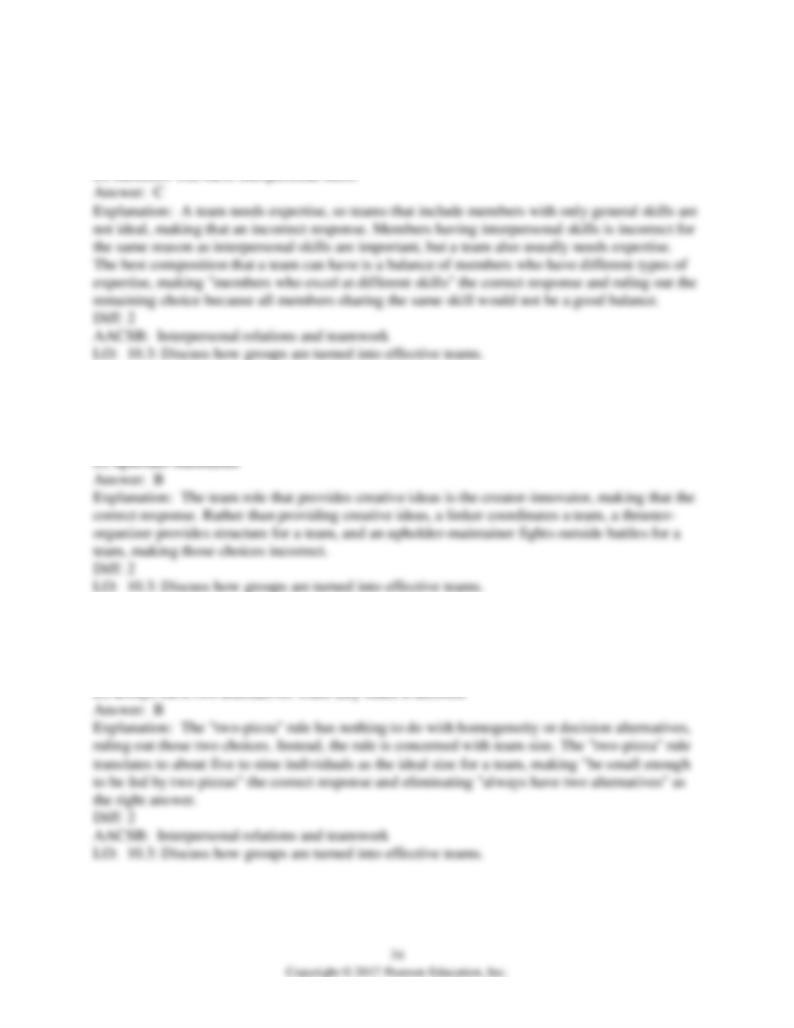
89) With respect to skills, most teams need this most.
A) members who excel at one particular skill
B) members who have only general skills
C) members who excel at different skills
90) A team that lacks new, interesting, exciting ideas needs someone to fulfill this team role.
A) linker
B) creator-innovator
C) thruster-organizer
91) The "two-pizza" rule holds that work teams should ________.
A) include a homogeneous group of people who all like just one or two kinds of pizza
B) be small enough to be fed by two pizzas
C) have 16 people or 2 eight-slice pizzas
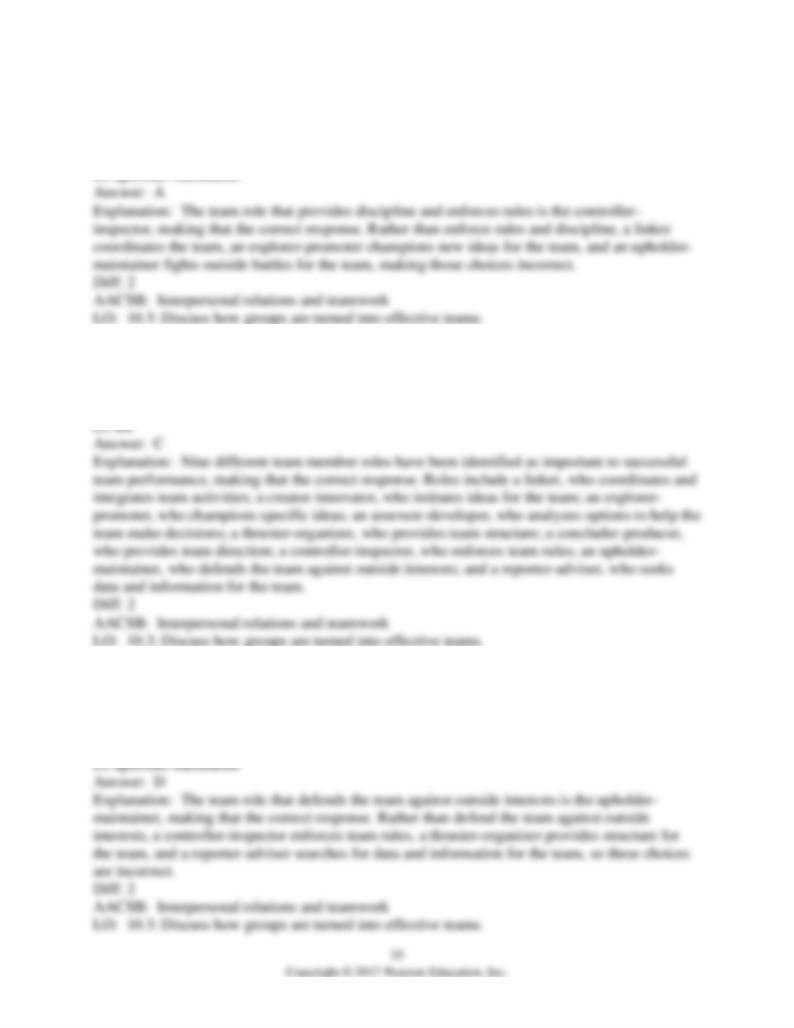
92) A team that lacks discipline needs someone to fulfill this team role.
A) controller-inspector
B) linker
C) explorer-promoter
93) Work teams that perform at a high level typically fill ________ different team roles.
A) six
B) eight
C) nine
94) A team that is suffering attacks by managers from another division needs someone to fulfill
this team role.
A) reporter-adviser
B) controller-inspector
C) thruster-organizer
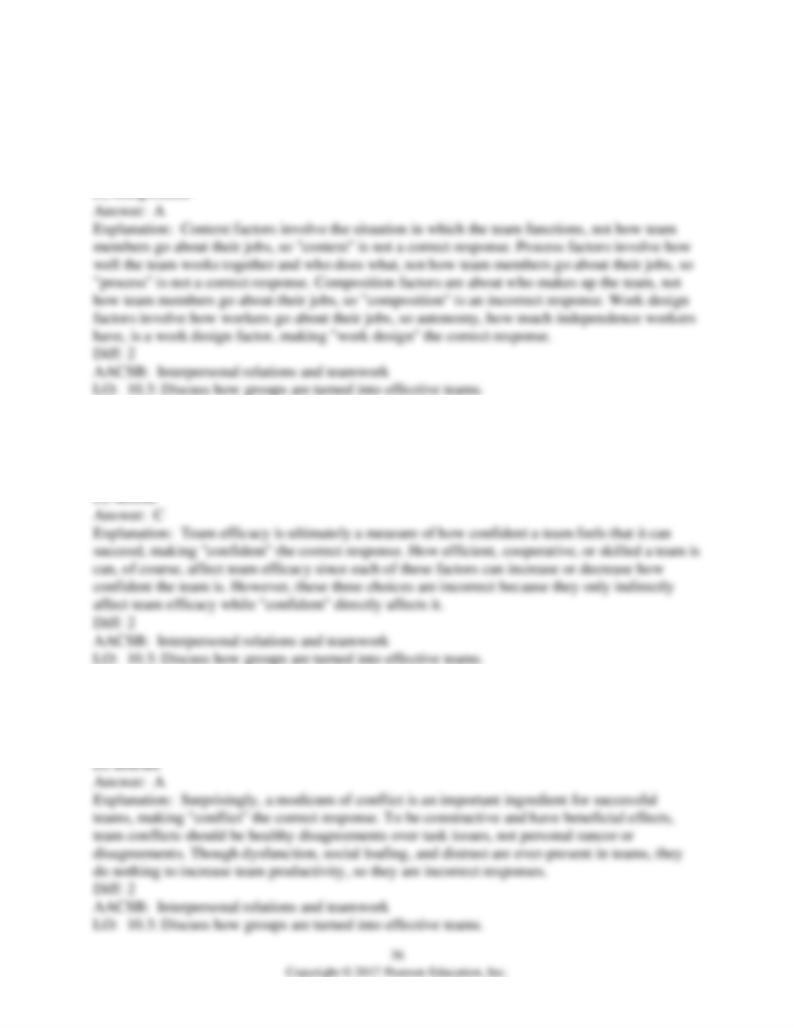
95) Autonomy is a ________ factor that contributes to team effectiveness.
A) work design
B) context
C) process
96) Team efficacy is a measure of how ________ a team is.
A) efficient
B) cooperative
C) confident
97) A certain amount of this is usually required for effective teams.
A) conflict
B) dysfunction
C) social loafing
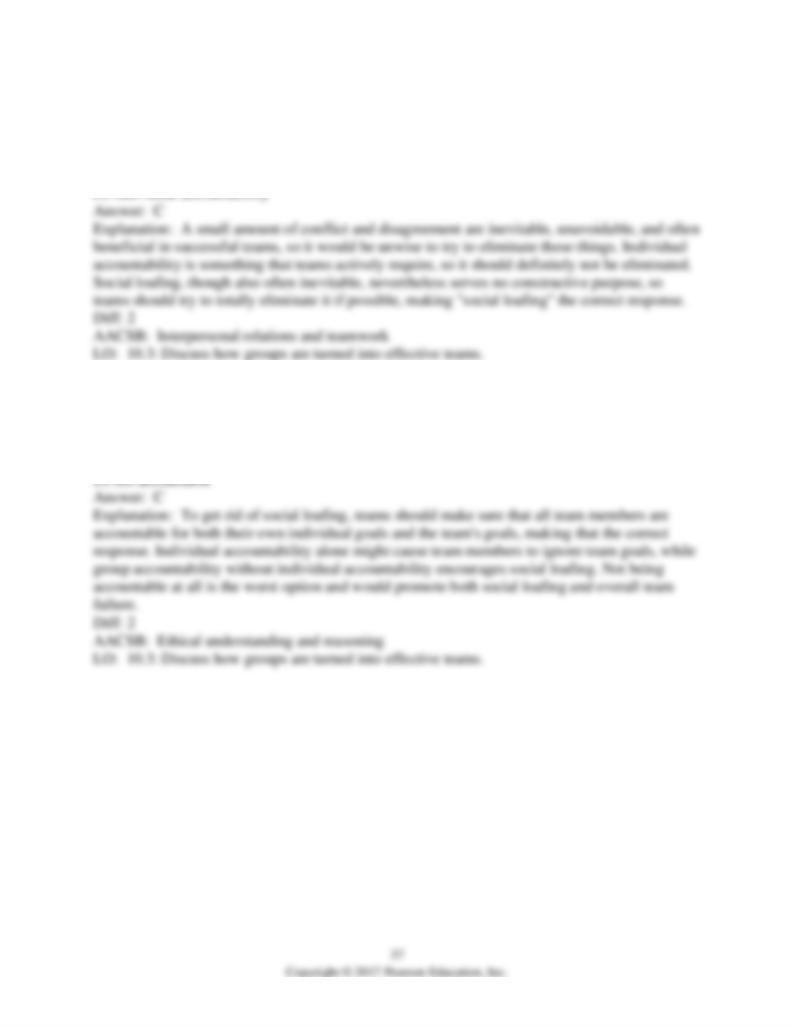
98) Which of the following should a team try to completely eliminate, if possible?
A) conflict
B) disagreement
C) social loafing
99) The best way to eliminate social loafing is to make sure that team members are ________ for
the team's goals.
A) individually accountable
B) jointly accountable
C) both individually and jointly accountable
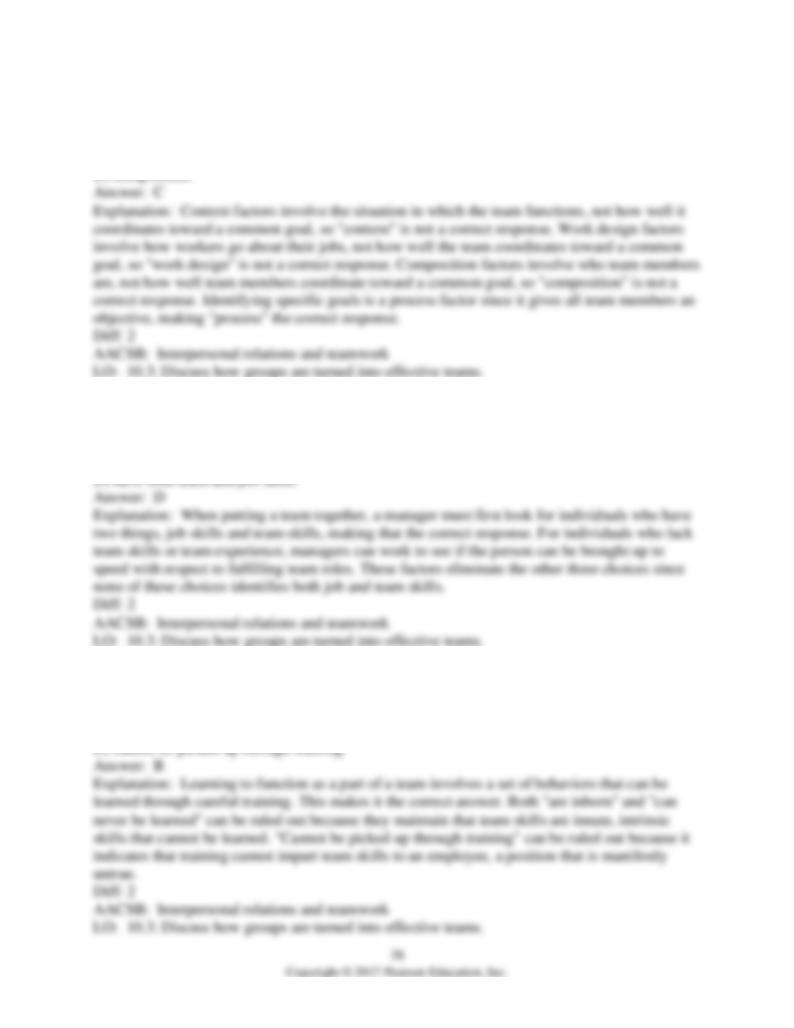
100) Specific goals are a ________ factor that contributes to overall team effectiveness.
A) context
B) work design
C) process
101) When assembling a team, managers should look for individuals who ________.
A) can avoid conflict and have team skills
B) have the required job skills
C) are team players
102) Team skills ________.
A) are all inborn
B) can be learned
C) can never be learned
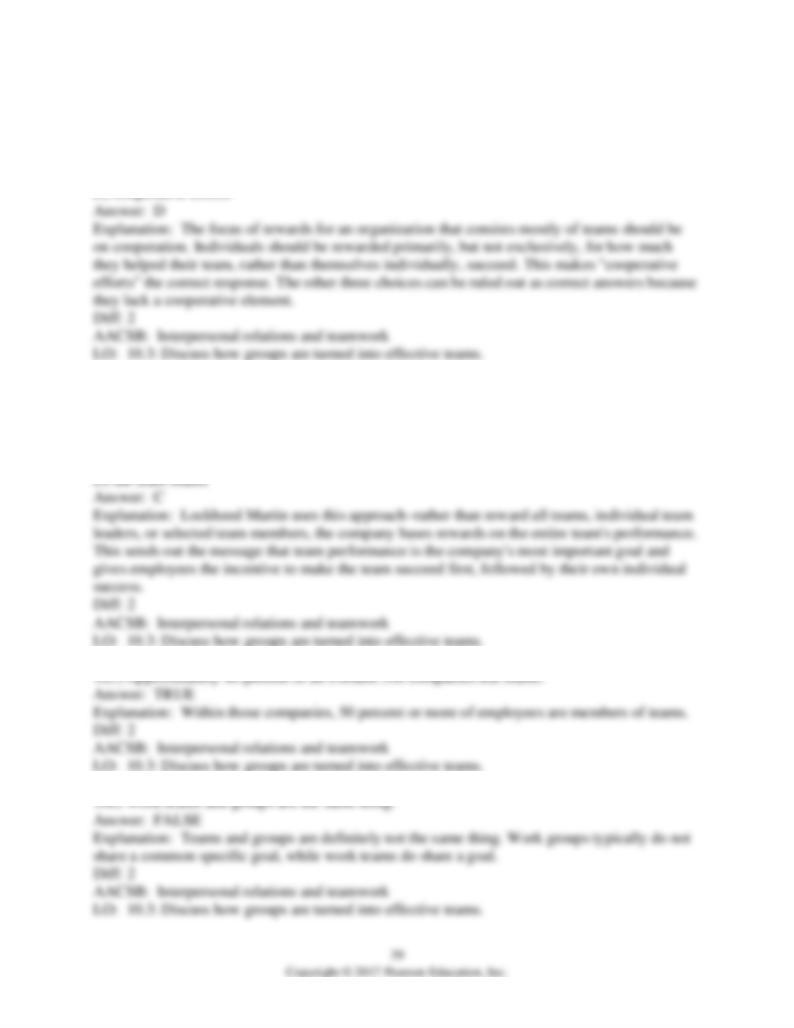
103) An organization that is composed predominantly of teams should reward employees
primarily for ________.
A) individual efforts
B) competitive efforts
C) being team leaders
104) One way to emphasize team cohesion is for employers to distribute rewards based on a
team's productivity to ________.
A) selected team members
B) all teams
C) the entire team
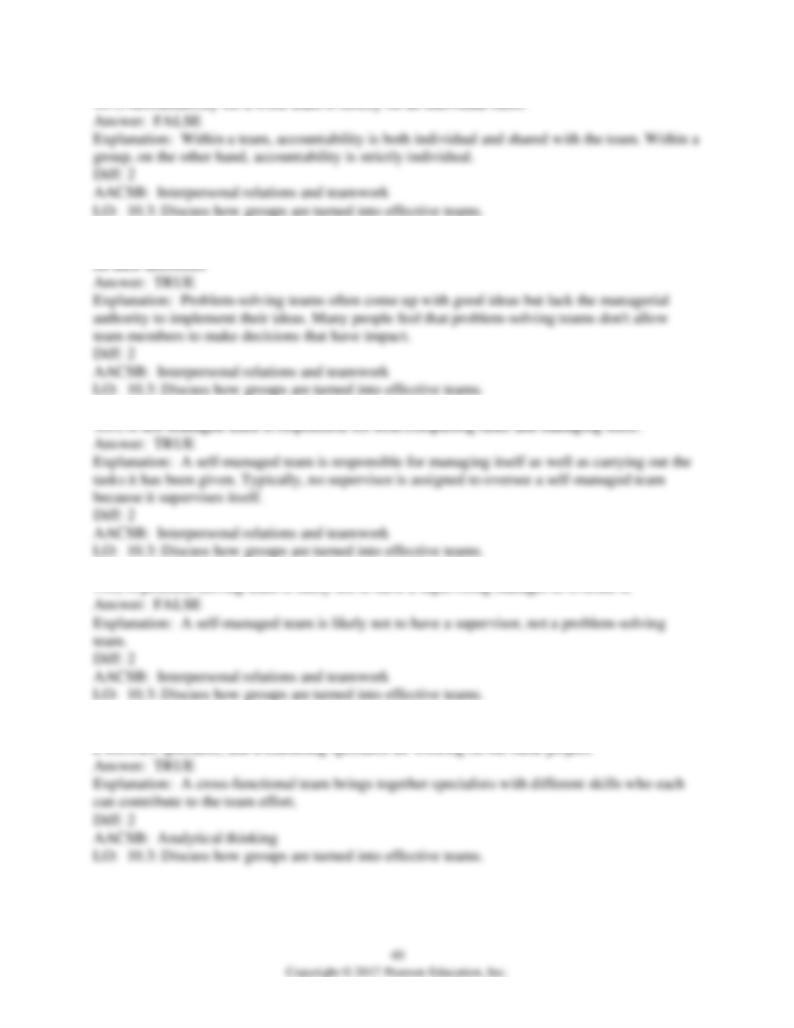
108) The problem with many problem-solving teams is that they don't have the authority to act
111) In an electronics company, a cross-functional team is likely to have an engineer, a designer,
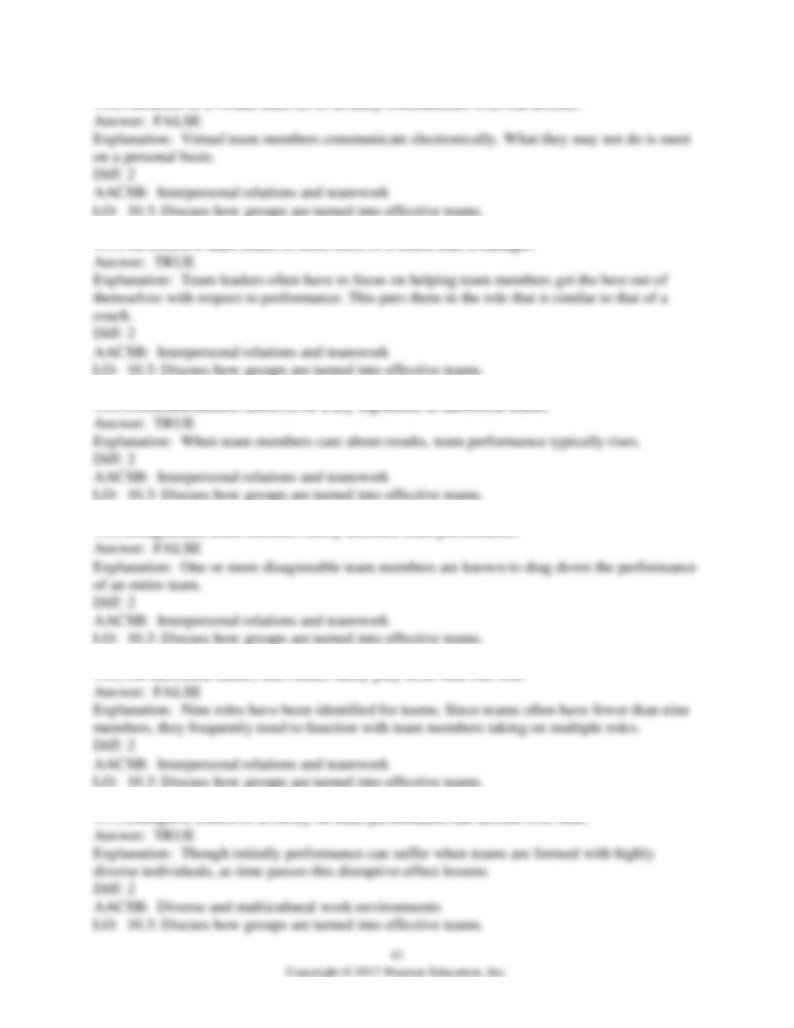
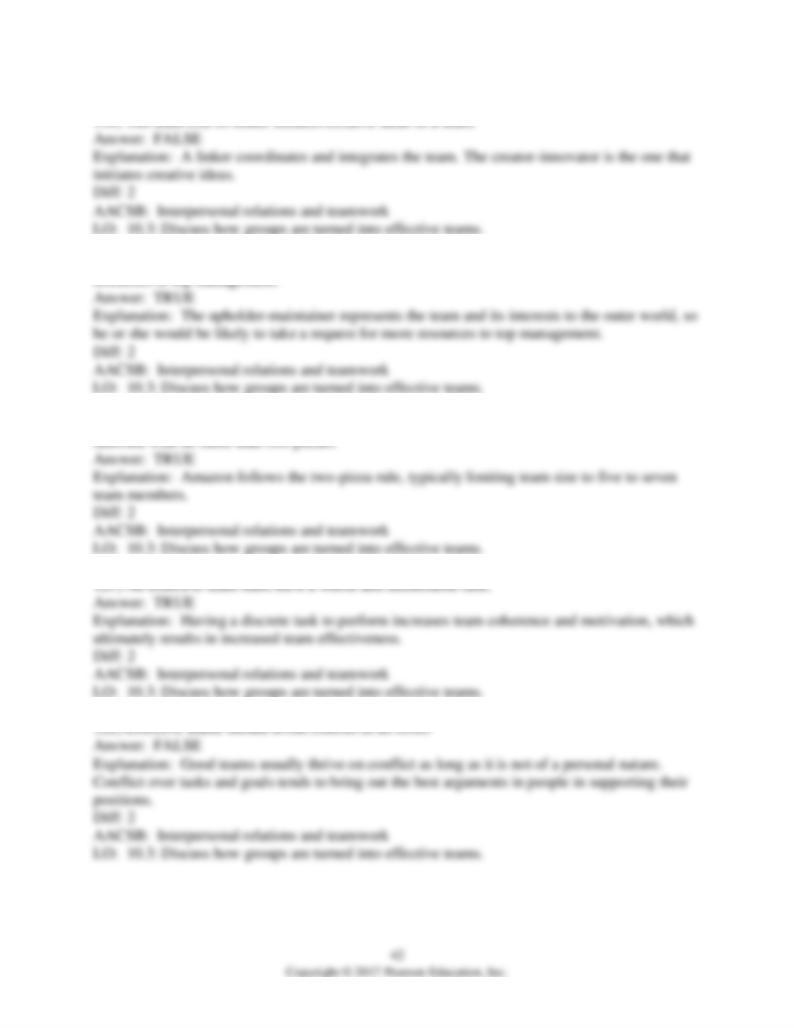
119) A team's upholder-maintainer would likely submit the team's request for a large increase in
120) The "two pizza" rule states that the best teams should be small enough so that they can be
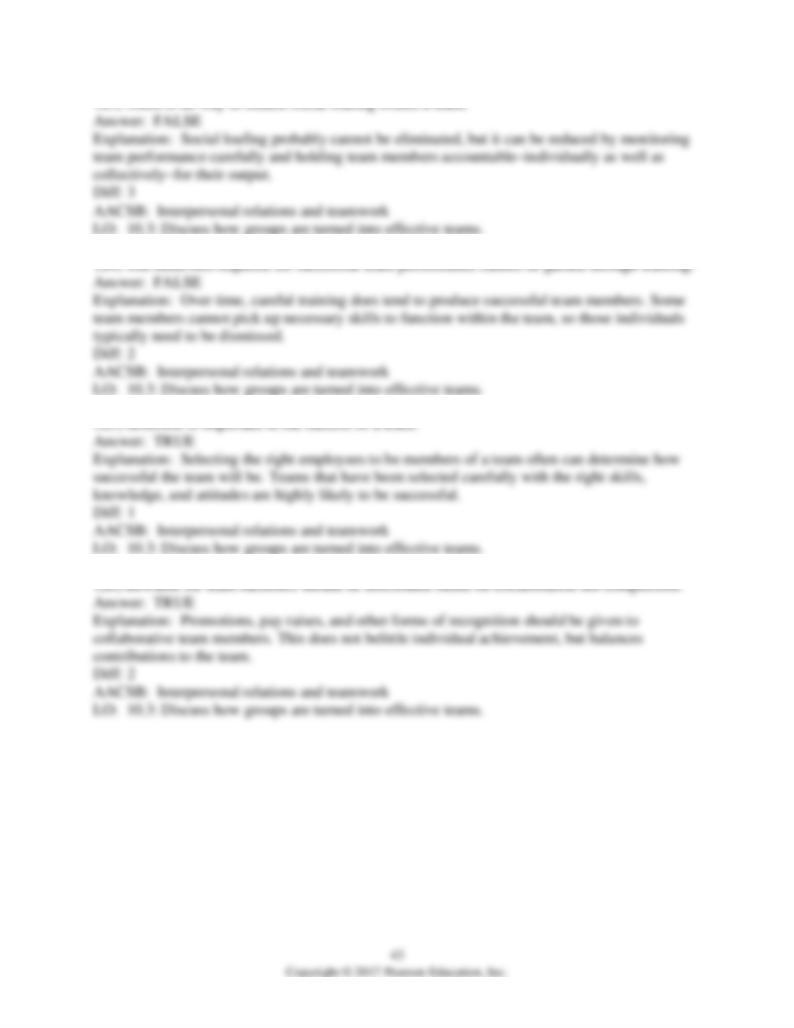
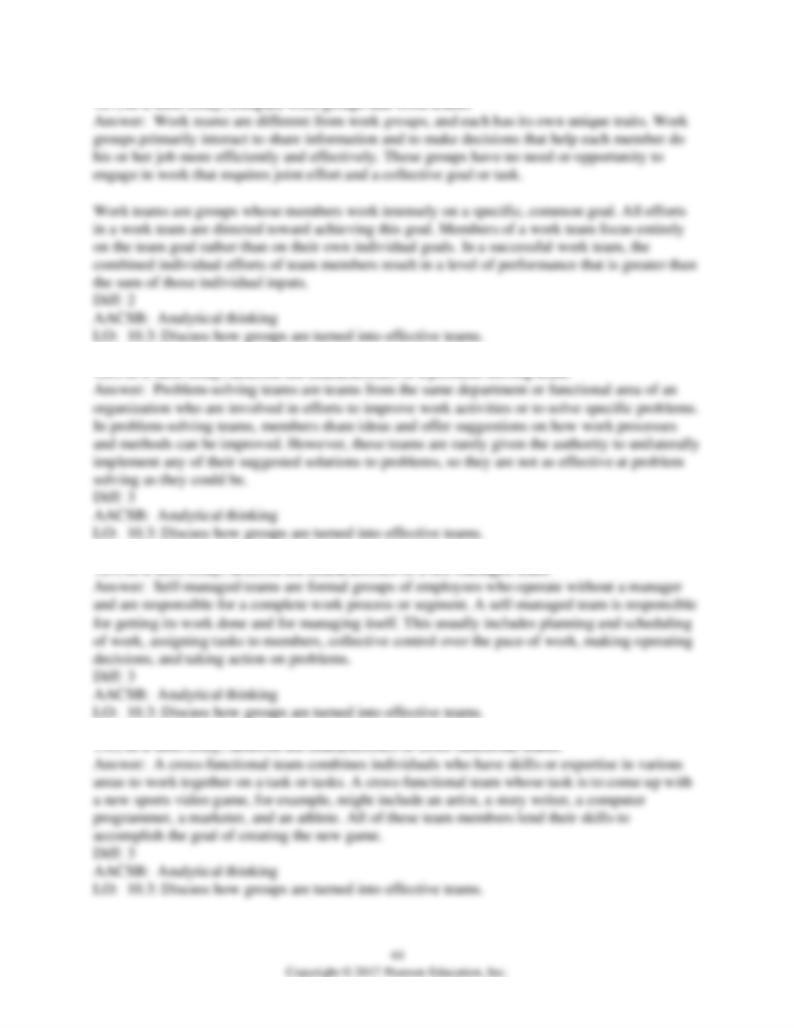
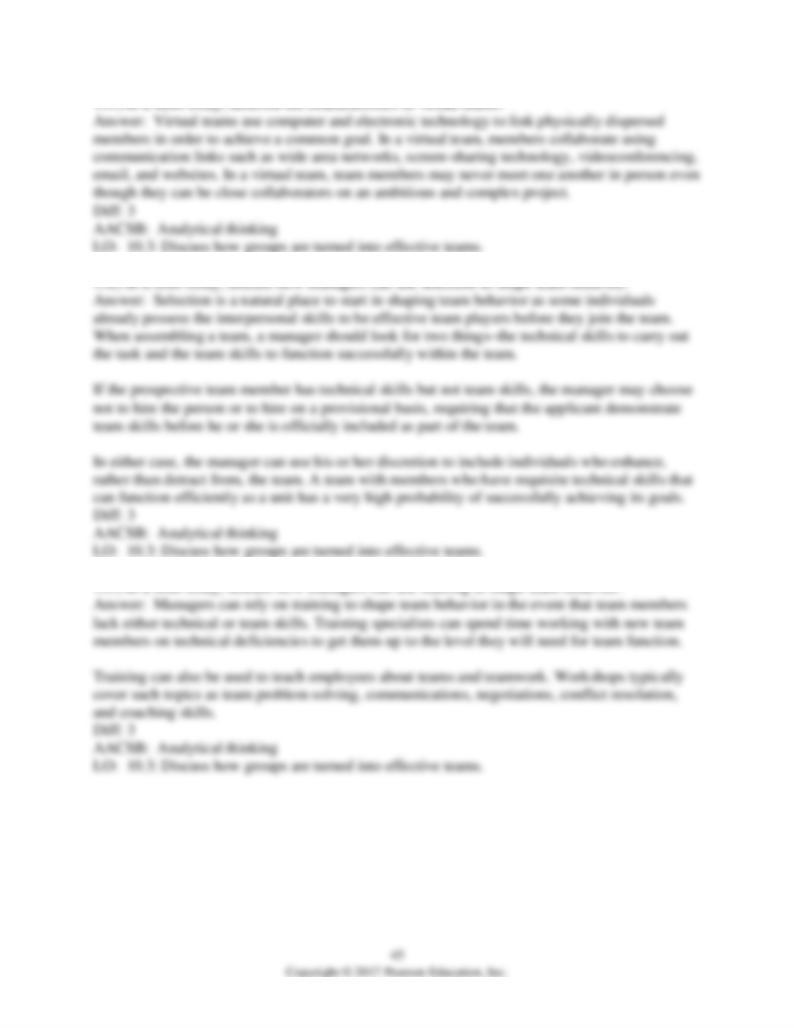
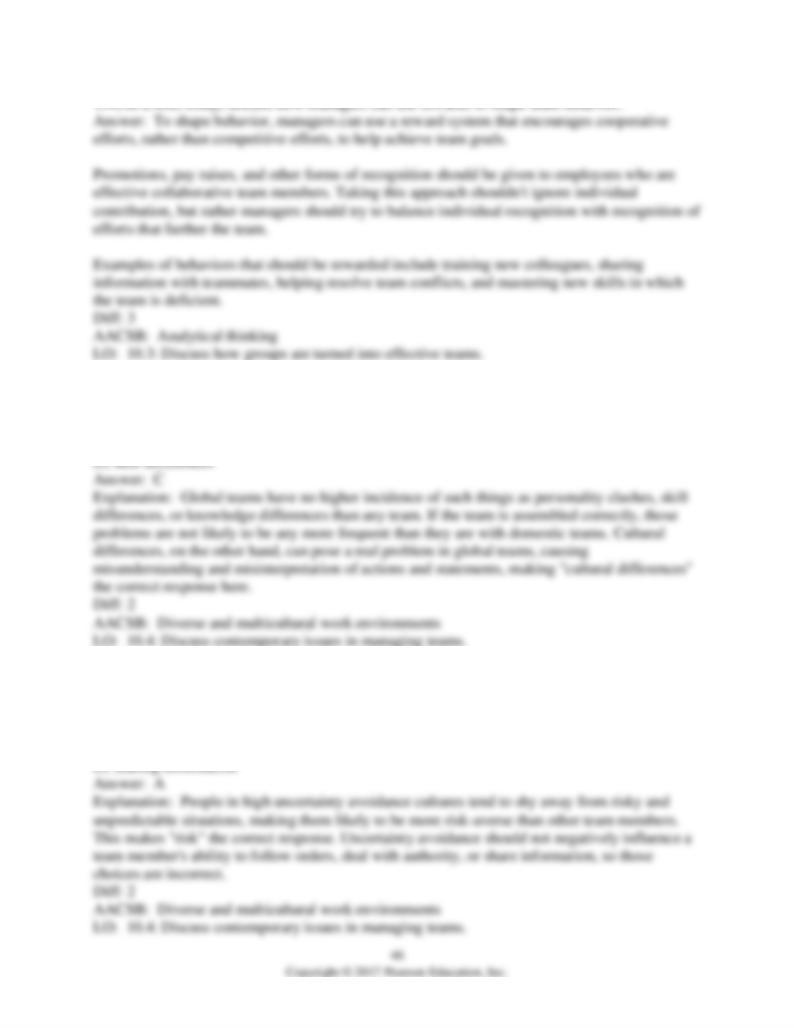
135) A major challenge of using global teams is ________.
A) personality differences
B) knowledge differences
C) cultural differences
136) A member of a global team from a country that has high uncertainty avoidance may have
problems dealing with this.
A) risk
B) authority
C) following orders
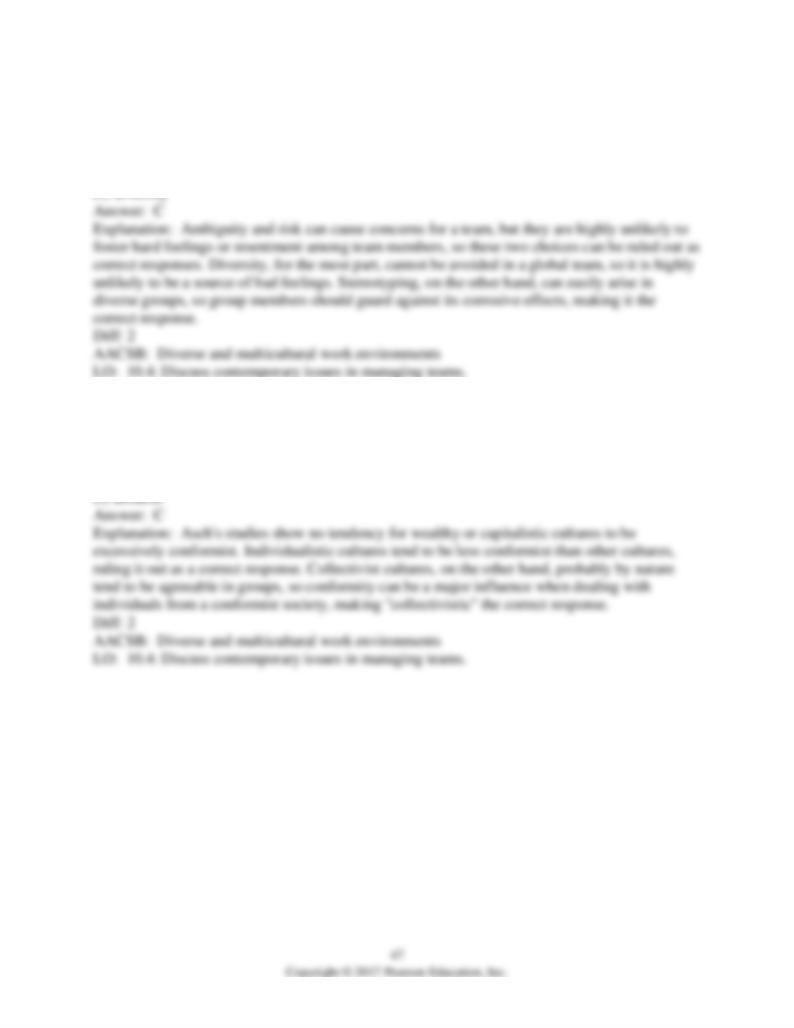
137) In a global team, team members should guard against ________, which can be a source of
discord and resentment among team members.
A) ambiguity
B) risk
C) stereotyping
138) Asch's findings show that ________ cultures tend to be more conformist than North
American cultures.
A) individualistic
B) capitalistic
C) collectivistic
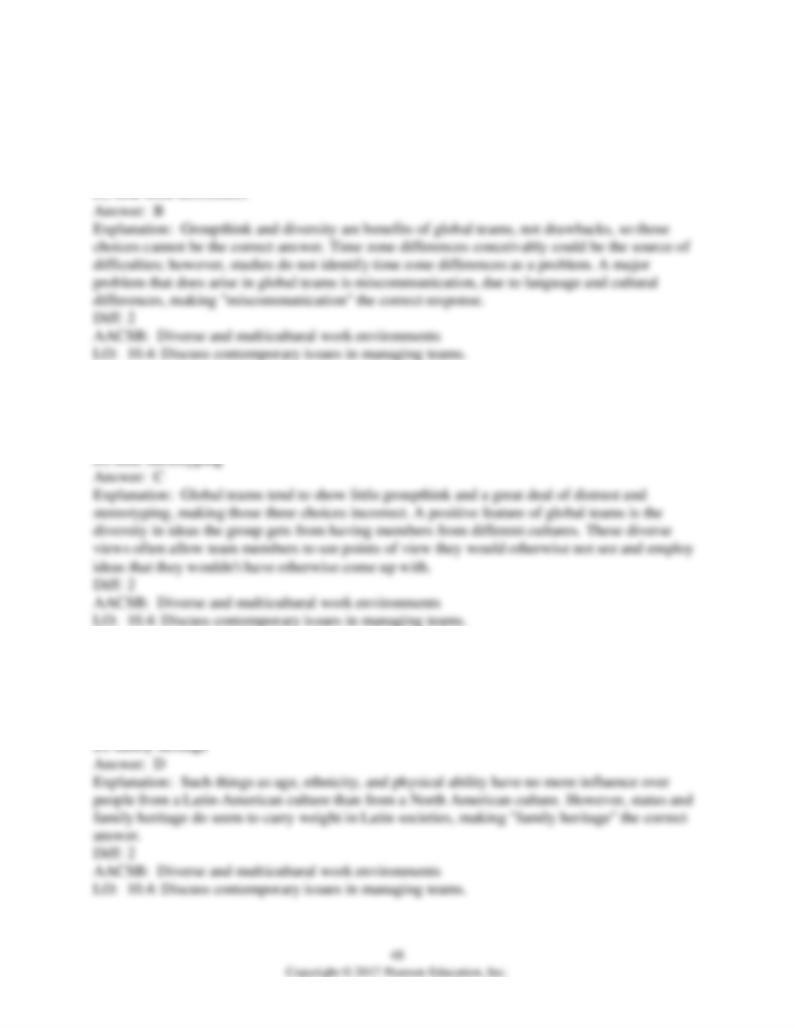
139) Research shows that a great deal of tension and difficulty arises in global teams due to
________.
A) groupthink
B) miscommunication
C) diversity
140) A major benefit of global teams is ________.
A) minimal distrust
B) groupthink
C) idea diversity
141) A Latin-American member of a global team might show undue respect to another team
member because of that member's ________.
A) age
B) physical ability
C) ethnicity
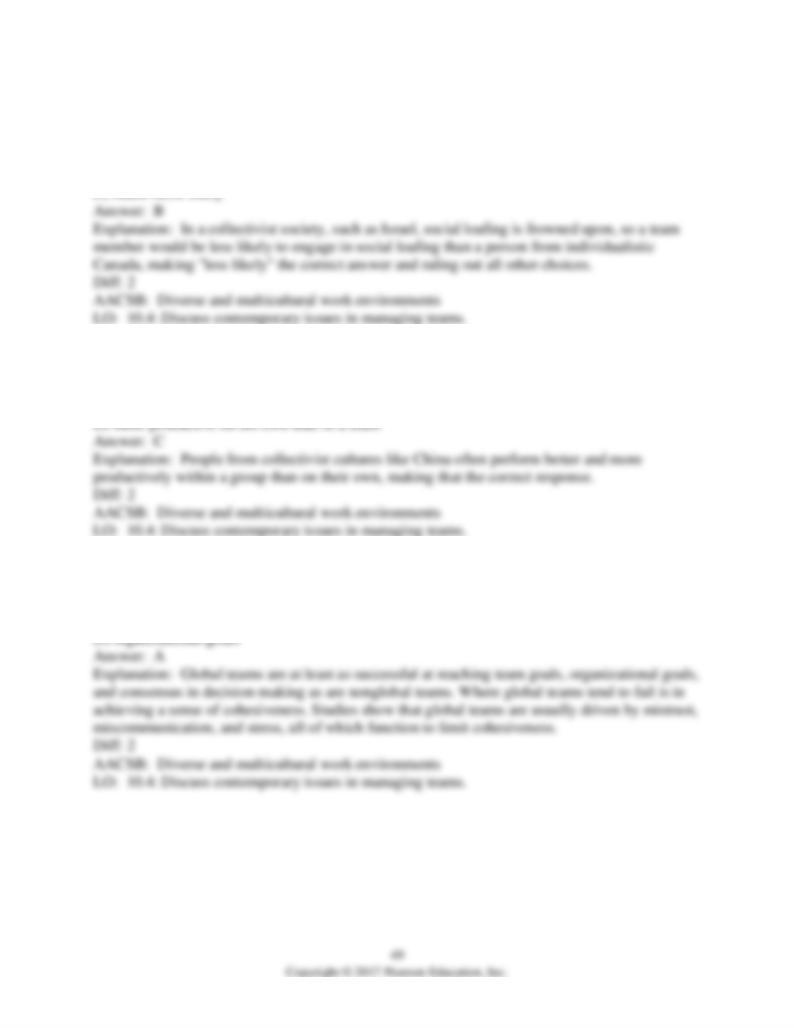
142) A global team member from Israel would be ________ to engage in social loafing as a team
member from Canada.
A) somewhat more likely
B) less likely
C) equally likely
143) A global team member from China would be likely to be ________.
A) less productive in a team than on his own
B) equally productive on his own and on a team
C) more productive in a team than on his own
144) This is one thing that global teams usually find difficult to attain.
A) team cohesiveness
B) consensus
C) team goals
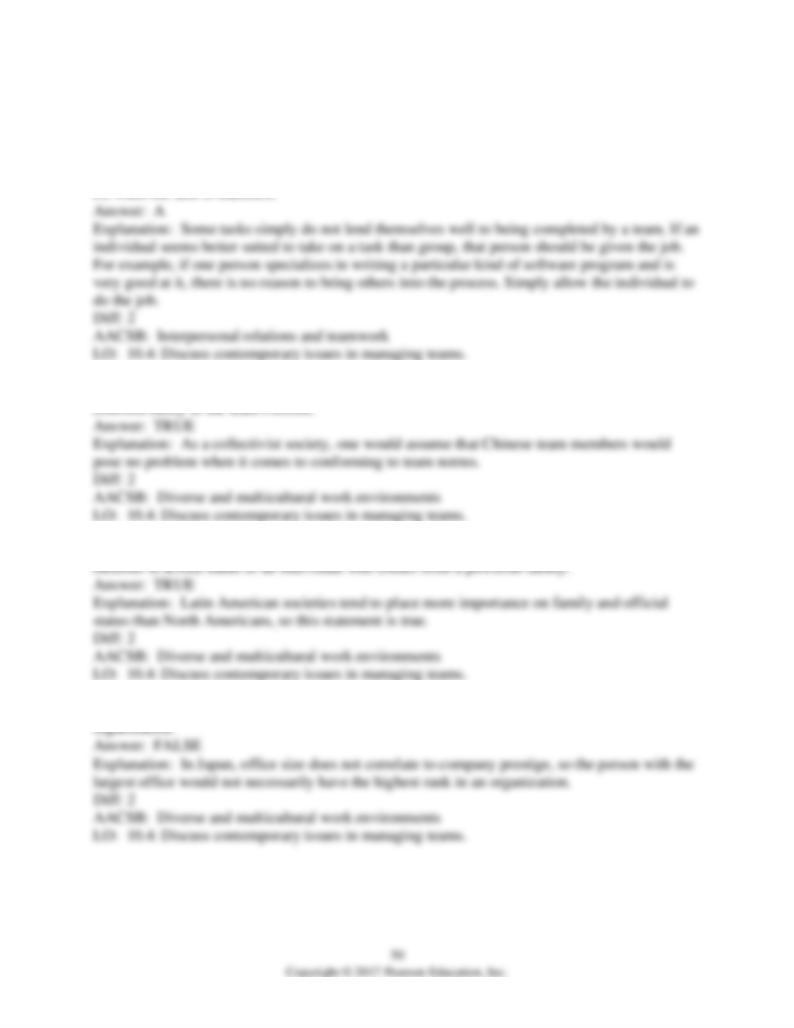
145) Which of the following identifies the most common reason for a manager deciding not to
assemble a team?
A) when the task can be better completed by an individual than a group
B) when the task is highly complex
C) when the task is ill-defined
146) Asch's findings suggest that Chinese members of a global team might be expected to
147) A Latin American team member would be more likely than a North American team
148) A Japanese manager with the biggest office is likely to have the most power within an
